Phalguni Ranjan
|
December 23, 2025
|
11
min read
Climate change in my cup: Why India’s cocoa and coffee production is at risk
Erratic rain and rising temperatures affect yield, bean quality and farmers’ willingness to invest
Read More
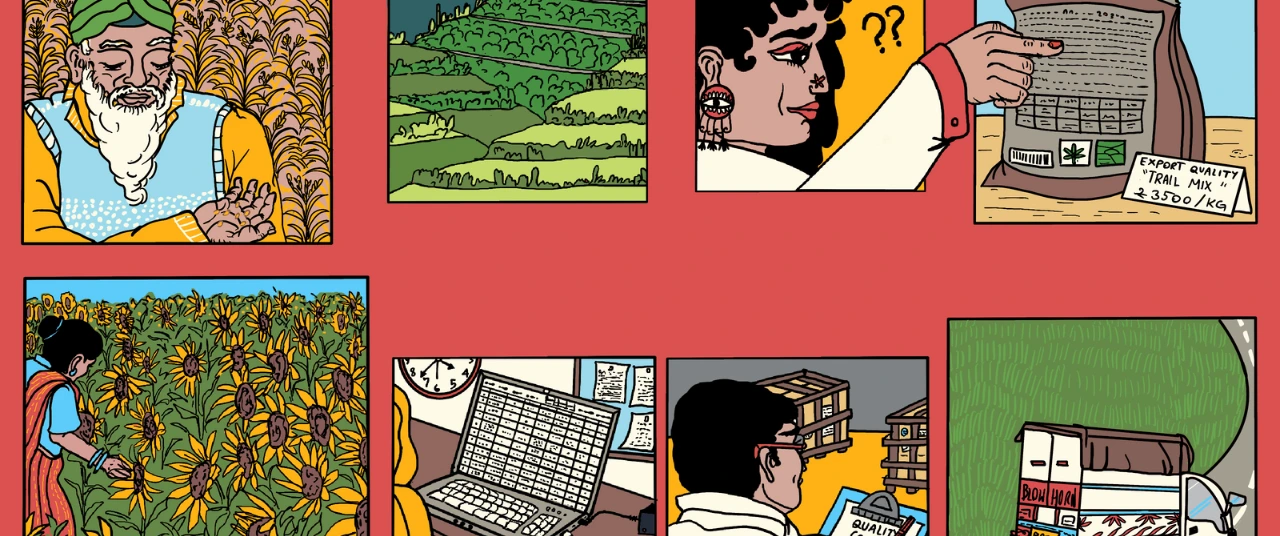
The solution lies not just in tightening rules, but also reducing the cost of compliance
The Plate and the Planet is a monthly column by Dr. Madhura Rao, a food systems researcher and science communicator, exploring the connection between the food on our plates and the future of our planet.
As consumers, do we have the right to know more about where our food comes from? With food borne illnesses and lifestyle disease statistics making headlines frequently, this is a fair question, but also one that is difficult to answer. Modern supply chains are vast, and even seemingly single-ingredient foods often come from multiple sources. Tea may be blended from several estates, coffee from different regions and honey from hundreds of small apiaries. For foods with many ingredients, tracing each component is even more challenging.
For consumers, this information is not always useful. What most people need is reassurance that the food they buy is safe and stands up to the various claims made on its packaging. For businesses and public authorities, however, knowing where each ingredient comes from is essential. When contamination or adulteration occurs, they must be able to identify where the problem began and act quickly to remove affected products. A reliable traceability system is therefore less about telling consumers every detail of origin, and more about ensuring that producers and regulators can track the chain of responsibility when needed.
In the past, supply chains were short and local, allowing producers and consumers to maintain direct relationships built on trust. Industrialisation and the consequent globalisation of food trade weakened those connections. As food began to move across states and countries, it became necessary to create systems that could record where a product came from, how it was handled, and where it was going next.
The modern understanding of traceability developed between the mid to late twentieth century when several food crises exposed weaknesses in existing systems. Globally significant events such as the outbreak of the mad cow disease in Europe in the 1980s and the adulteration of Chinese infant formula with melamine in 2008 had far reaching public health consequences, pushing countries to recognise traceability as essential to public health. In the 1960s, the Codex Alimentarius Commission, a joint body of the Food and Agriculture Organization (FAO) and the World Health Organization (WHO), set international standards for food safety and fair trade. It defines traceability as ‘the ability to follow the movement of a food through specified stage(s) of production, processing and distribution’. The Commission regularly revises its guidelines to reflect new scientific developments, and its framework serves as the foundation for most public and private traceability systems worldwide. Today, traceability in food supply chains has moved from paper records to digital systems that use barcodes, Radio Frequency Identification (RFID) technology and even blockchain, making it possible to trace the source of even the most minute ingredients in products that have travelled halfway across the world.

Also read: A new science-backed Planetary Health Diet is in the spotlight. How does the Indian diet measure up?
Indian agriculture is dominated by rural smallholders. A single supply chain can include hundreds of farmers cultivating small and scattered plots of land. Many have limited access to smartphones, stable internet or digital literacy tools. Similarly, processing activities are undertaken by lakhs of small and medium sized factories around the country. Transactions are still recorded on paper, and even when they are digitised, they are often not managed effectively. Tracing the source of an ingredient can therefore mean searching through paper ledgers or incomplete digital files instead of accessing a well-maintained database.
Export markets, where transparency is rewarded through price premiums and market access, make such investment worthwhile. In contrast, domestic buyers rarely pay more for traceable produce, so food businesses have little incentive to adopt these systems.
Developing robust traceability systems is also expensive. Setting up the digital infrastructure, organising audits, obtaining certifications, and training quality assurance and administrative personnel requires continuous investment. For small producers operating on narrow margins, these costs are difficult to bear unless traceability leads to higher returns. Export markets, where transparency is rewarded through price premiums and market access, make such investment worthwhile. In contrast, domestic buyers rarely pay more for traceable produce, so food businesses have little incentive to adopt these systems. As a result, export-oriented supply chains in India have developed strong traceability systems, while those serving domestic markets often rely on fragile documentation practices and informal networks of trust among the many actors involved.
The Food Safety and Standards Act of 2006 provides the legal basis for food control in the country, while the Food Recall Procedure Regulations of 2017 require manufacturers to withdraw unsafe food and communicate with consumers when necessary. In 2022, a survey of 30 food businesses in Delhi and the National Capital Region revealed how limited domestic traceability remains. Nearly all participants used barcodes to display retail prices, but only a small fraction maintained recall or traceability protocols. Many companies were unaware of how to trace products backward to their source or forward to distributors in case of a safety issue. This suggests that the tools of traceability exist but are used primarily for labelling and pricing, not for safety or accountability.
Sustainability certifications rely on detailed records that show where ingredients come from, how they were grown, and which standards were followed at each stage of production. Without this chain of evidence, sustainability labels would have little meaning.
Milk, for instance, is a product where quality lapses continue to be reported. Raw milk often moves through a chain of village collectors, chilling centres, transporters, and small dairies before it reaches consumers, and problems can arise at several points along this route. Periodic surveys by public authorities and independent researchers have found both dilution and the use of substances such as detergent in different regions. Paneer faces comparable challenges. Alongside batches made from low quality milk, there is a growing market for analogue paneer made with processed vegetable fats and other non-dairy ingredients. This can amount to food fraud when such products are sold as paneer without clear disclosure, leaving consumers unsure of what they are actually purchasing. Much of this activity takes place in small, informal units with limited records, so when adulteration or mislabelling is detected, authorities often struggle to identify the specific source and must issue broad advisories instead of targeted action.
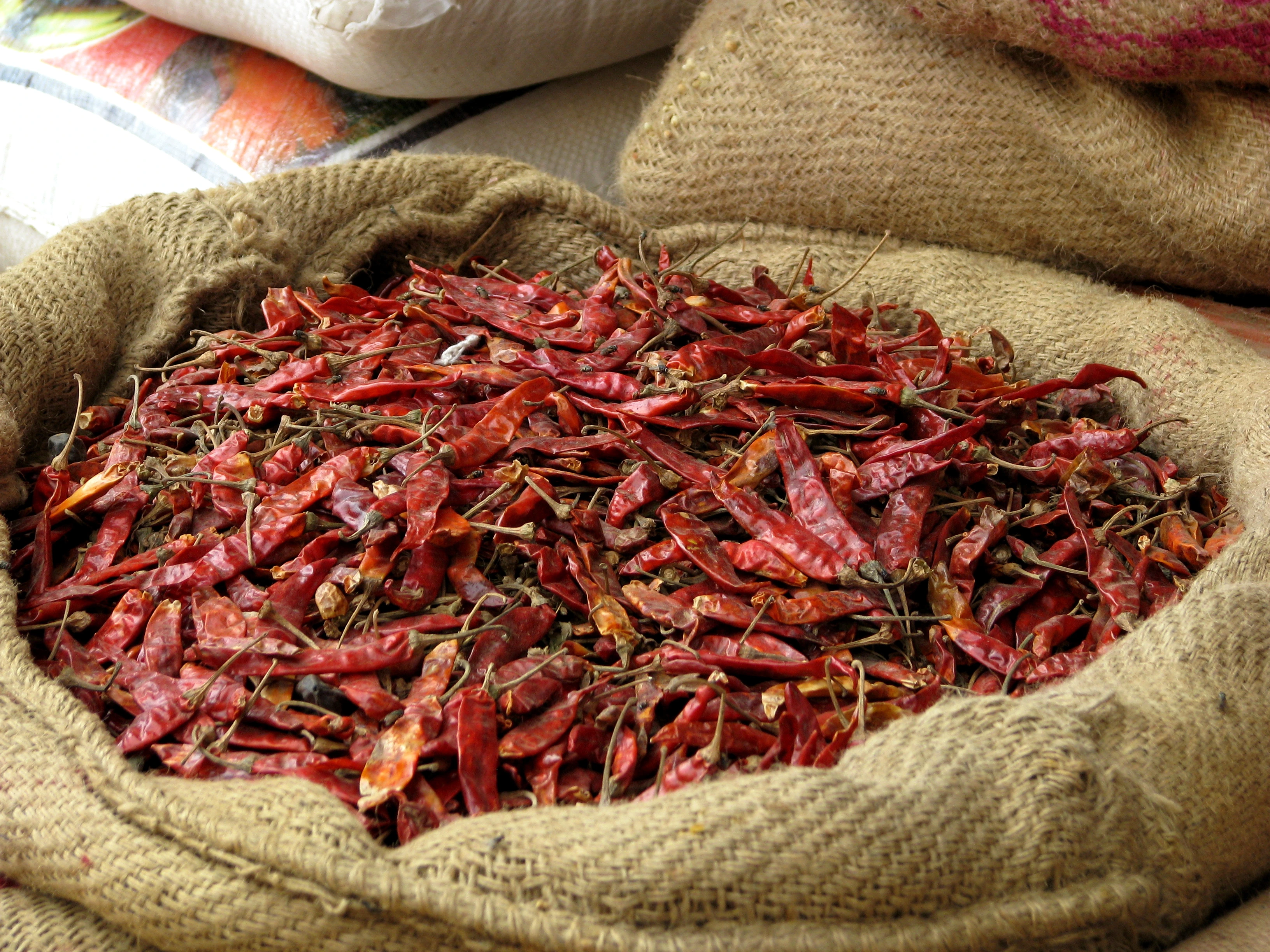
The weaknesses in domestic traceability have contributed directly to recurring cases of contamination, adulteration and foodborne illness. The FSSAI frequently issues alerts and recalls, and one of the most prominent recent examples involved packed spice blends, which came under scrutiny both abroad and at home in 2024, after multiple countries detected the carcinogenic pesticide ethylene oxide in popular brands. Weak traceability systems mean that investigations must rely on manual records, supplier declarations, and blanket bans leading to financial losses for businesses and an erosion of trust among consumers.
Traceability today goes beyond food safety and has become an important tool for ensuring environmental and social sustainability as well. Sustainability certifications rely on detailed records that show where ingredients come from, how they were grown, and which standards were followed at each stage of production. Without this chain of evidence, sustainability labels would have little meaning. An organic label is based on proof regarding a production system being free from synthetic fertilisers, pesticides and genetically modified inputs. Fair trade certification verifies that farmers receive fair prices and work under safe conditions. Other claims, such as ‘rainforest certified’ or ‘shade-grown’, are linked to biodiversity protection, while ‘cage-free’ and ‘free-range’ labels concern animal welfare.
Sustainability certifications such as these are often treated as add-ons that signal higher ethical or environmental value and therefore command a price premium in the market. In the Indian context, as with food safety, such traceability systems are found mostly in export-oriented sectors. Products sold domestically seldom undergo the same level of verification, and sustainability claims remain limited to a small, urban consumer base that can afford to pay more for them.

Setting up traceability systems is an expensive affair, and it is usually large manufacturers, supermarket chains, and export-oriented companies that have the resources to build and maintain them. For smaller suppliers and local retailers, the same requirements are far more difficult to meet. When only large companies can afford to meet compliance requirements, supply chains begin to be increasingly controlled by them. To ensure that every product can be traced, these firms often bring more of the production process under their direct control, a strategy known as vertical integration. In a vertically integrated supply chain, a company owns or manages several stages of production, such as farming, processing, packaging, and distribution. This can make traceability easier, but it also concentrates decision-making power, leaving less room for small and independent actors.
Instead of simply tightening rules, regulators can focus on reducing the cost of compliance.
Public supervision can help avoid this outcome. Regular inspections and transparent monitoring by government authorities can make traceability a shared responsibility rather than a private asset. Instead of simply tightening rules, regulators can focus on reducing the cost of compliance. Affordable digital tools, publicly funded data storage platforms and simplified reporting formats would allow small and informal businesses to meet basic traceability standards without being forced out of the market. This is especially important in India, where about 1.2 crore kirana stores account for more than 90% of sales in the Rs 67 lakh crore ($810 billion) food and grocery market. These small businesses are central to the economy and to the daily lives of ordinary consumers, which makes it essential that systems of safety and accountability are designed to include them. Additionally, penalties for deliberate fraud and mislabelling remain necessary not only to deter malpractice, but to protect public health—and ensure that honest and compliant businesses can compete fairly, without being undercut by those who cut corners.
Also read: Ultra-processed foods are reshaping our diets. Should we be worried?
Artwork by Alia Sinha
{{quiz}}

Falling appetite and hormone changes make it harder to eat healthy and retain mobility
Editor's Note: From grocery lists, to fitness priorities, and even healthy snacking, protein is everywhere—but do we truly understand it? In this series, the Good Food Movement breaks down the science behind this vital macronutrient and its value to the human body.
What does it mean to age? Is it just the wrinkles, strands of grey hair, and constant back pain? These are just glimpses of the larger slowing down of the grand, complex machine that is the human body. Behind the scenes, cells grow old and tired, and the body is not able to send newer cells to relieve them. Organs that have served the body for decades take longer and need more support to execute the same functions. The body retains adequate functionality to keep us afloat, but stressors like injuries or disorders can rock the boat uncomfortably.
It can feel very helpless and frightening to watch a strong body falter like this. Some of that helplessness is reasonable, but your diet and physical exercise levels influence how deeply this wear and tear impacts your body. India's elderly population (aged 60 and above) has increased four-fold over the past 50 years. In 2019, of the estimated 136.6 crore population of India, the number of aged population (>65 years) was 8.7 crores, and by 2050, it is expected to reach 22.5 crores. This makes it crucial that we understand nutrition for the elderly.
As you age, your body is dealing with two problems at once: you are struggling to absorb nutrients the way you used to, and your body needs them more desperately than before. Why exactly does ageing make it harder to access nutrition?
Firstly, your body's systems to pick up on hunger signals get disrupted. Biological factors like reduced production of hormones and slowing stomach digestion make up one part of this. Additionally, vision, smell, and taste slowly start deteriorating sometime in mid-life (between 40 and 60 years of age). Though not directly related to digestion, these three senses are core to how we experience food. Without them, how can one look forward to mealtime? The very act of eating becomes bereft of joy, and caloric intake falls. Common dental issues like decreased saliva production, difficulty in chewing, and loss of teeth can further interfere with how appetising meals are. At the same time, you are exercising lesser, and your resting metabolic rate (basic energy expenditure for keeping organs functional) is falling—thus reducing your caloric needs. Energy levels fall too, and people have little motivation to spend it on preparing food. Together, this makes it hard for older folks to eat well.
While their appetite suffers, so does the absorption of nutrients. Stomach acid levels fall, digestive enzyme production slows, the composition of the gut microbiome changes which specifically make it harder to absorb vitamins, minerals, and proteins. Intestinal motility, or the intestine’s ability to contract and dilate, also weakens with age, and slows down the transport of digested nutrients. Decreased functioning of the proteins that are responsible for amino acid transportation decreases the efficiency with which the body is able to absorb it. Older people also run a higher risk of developing gastrointestinal disorders that affect digestive processes and bioavailability of nutrients.
Also read: The science behind bodily protein: What are complete and incomplete sources?
For women, age also marks an important shift: menopause. Almost an entire life of periods can predispose anyone to celebrate their end, but menopause brings its own troubles. Throughout menopause, which usually starts in the 40s and can last for up to a decade, estrogen levels fluctuate until they fall and plateau. Estrogen regulates not just the menstrual cycle, but also appetite. The sudden reduction in the production of estrogen, as happens during menopause, is associated with an increase in abdominal fat. It also speeds up the loss of bone density in women. These losses come from a higher rate of breakdown compared to synthesis in muscles. Protein is crucial to reducing the imbalance between the two, and reducing the net breakdown of muscle and bone mineral mass. In these ways, protein is all the more crucial for women as they enter menopause.
Also read: Protein traceability: Why knowing where your milk and pulses come from matters
The fundamental rules of good nutrition stay the same with the elderly—but reduced appetite makes it harder to ensure they get it, and the results of a deficiency have greater ramifications.
Older folks are especially prone to developing a protein deficiency. Not only is digestion and absorption affected, difficulty in chewing and swallowing also restrict access to rich sources of complete protein like meats. They are also less responsive to anabolic (muscle synthesis) stimuli when the amino acid levels are low, i.e. they need a larger dose of protein to get the same results as younger adults.
How this increased need is expressed changes. Some express it as a Recommended Daily Allowance (RDA) of 1.2-2g per kg of body weight. However, the RDA was calculated by a methodology that estimated how much protein is required to ensure the body does not lose nitrogen, rather than through a focus on how protein is impacting bodily strength and functions. In its place, protein intake can be measured in terms of the Acceptable Macronutrient Distribution Range (AMDR). AMDR expresses nutrient intake as a percentage of total energy intake, and recommends 10-35% of the total energy for protein. AMDR is especially useful while discussing the nutrient needs of older adults, because their total caloric intake falls with age, and focusing on a percentage can help ensure that an adequate proportion of their diet is including protein. At the same time, it is advised that around 55% of caloric intake be carbohydrates to prevent the body from breaking down protein for energy.
One of the major impacts of a protein deficiency is an acceleration of age-related muscle mass loss (sarcopenia) and bone density loss (osteopenia). It leads to a drop in strength and functionality, and has a direct relation to loss of independence and mobility among elderly adults. It is also associated with frailty, an increased risk of injury, and longer recovery times.
Adequate protein is thus central to retaining functionality as we age, and to work best, it must be paired with exercise. Studies have shown that even five days of bed rest reduces muscle protein synthesis in the elderly—a worrying sign of what an injury or hospital visit can mean for muscle breakdown. In contrast, any form of physical activity has benefits, and can help reverse mobility functions that have been lost. High-intensity strength training is recommended for those prone to muscle loss and frailty.
Regular exercise and a balanced diet become all the more important with age because the body’s failing systems make it harder, both physically and emotionally, to take care of ourselves. Moreover, the body’s disposition to lose muscle mass and to get injured make protein a crucial nutrient to ensure strength and recovery. Ensuring that an elderly adult gets the protein they need involves some planning, but with it comes a satisfying reward: true independence, well into old age.
Also read: The ‘right time’ to eat protein: Little and often, rather than in one meal
{{quiz}}
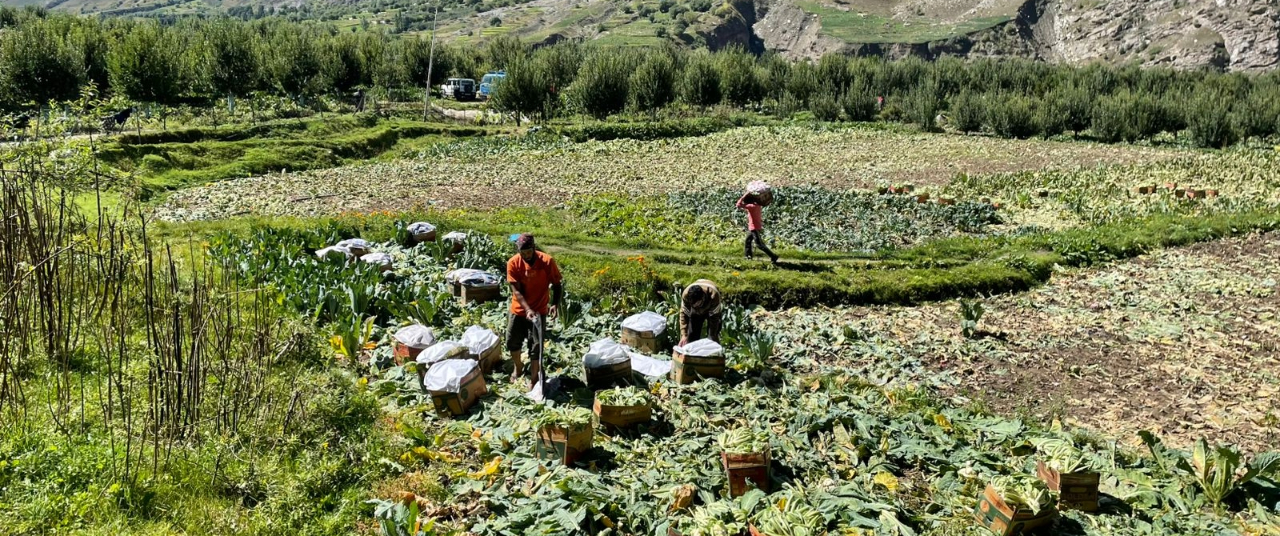
A series of floods and landslides has raised questions about strategies to survive climate disasters
In the Tholang village of Himachal Pradesh’s remote tribal district of Lahaul and Spiti, Sahm Azad, a 45-year-old farmer, stands beside what remains of his cabbage and iceberg lettuce fields. Over August and September, he grappled with devastating losses after heavy rainfall, cloudbursts, and landslides that battered the region this monsoon.
Azad, who owns less than three acres of land and depends entirely on a single crop cycle between April and October, says his annual income—around Rs. 4 to Rs. 5 lakh—has vanished overnight. “Almost everything we grew has been destroyed. What little survived couldn’t even leave the valley because the roads were gone,” he says. “We usually cover our yearly expenses with one crop, but this time, we’re worried about how we’ll feed our families.”
Lahaul-Spiti, which remains buried under snow for nearly six months each year, is known for its short but lucrative growing season. During summer, farmers cultivate high-value vegetables—peas, potatoes, cabbage, broccoli, lettuce, and other exotic varieties—that are sent to wholesale markets in Delhi and Chandigarh, and supplied to five-star hotels across northern India. The exotic vegetables, in particular, enjoy an “unlimited market;” for the cool temperatures of May to October in the hills give them an advantage over the warm plains, which offer no competition.
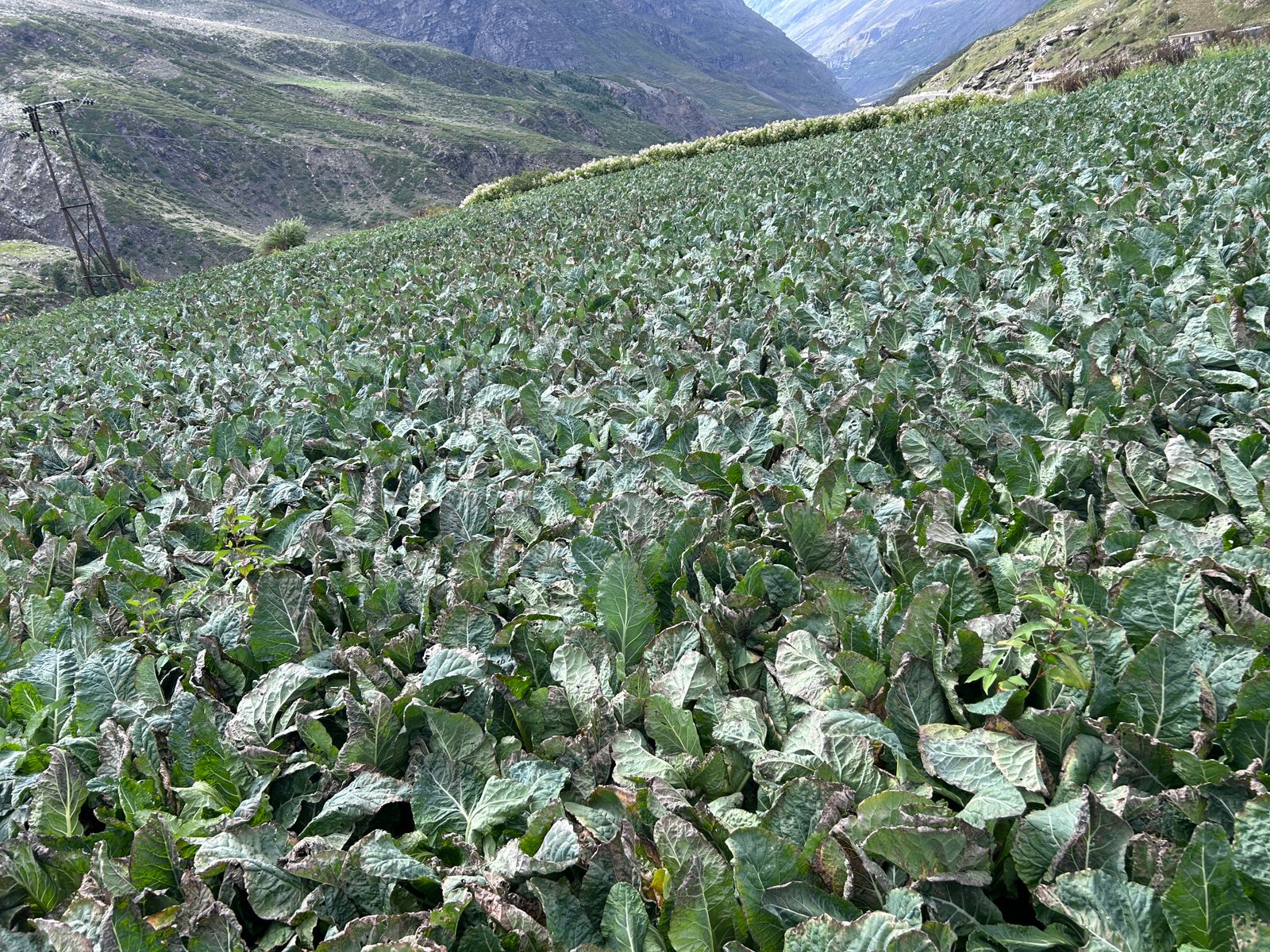
As a result, over the last decade, a growing number of cultivators in the state have switched over from cereals to exotic vegetables and horticulture. For thousands of farmers and labourers, these crops are the backbone of their livelihoods.
This year, however, that backbone has been shattered. Between August 22 and 27, heavy rains triggered landslides that cut off major highways and isolated entire valleys, severely damaging stretches of the Chandigarh–Manali four-lane and the Manali–Leh highway. For nearly three weeks, Lahaul-Spiti remained inaccessible to the rest of the state.
With access blocked until early September, vegetables ready for harvest could not reach the markets. Entire truckloads of produce—harvested after months of labour—rotted in the fields.
For nearly three weeks, Lahaul-Spiti remained inaccessible to the rest of the state.
Now, the next crop cycle, too, is at risk. Heavy rains and landslides have damaged agricultural irrigation systems across the valley. Farming in Lahaul relies primarily on “kuhls,” small traditional canals that divert glacial water to the fields. Many of these have been washed away or broken. “The irrigation of our fields depends entirely on these canals,” Azad says. “If they are not repaired soon, sowing after April next year will be affected. Once snowfall begins, repair work will become impossible.”
“All our hard work has been wasted,” says Motilal, a 52-year-old farmer from Madgran village in Udaipur. “This isn’t the first time weather has ruined our crops, but the scale of the damage in the last few weeks has been enormous. Farmers across villages are drowning in debt, and confidence in farming is fading fast.”
According to data from the Lahaul-Spiti Agriculture Department, cabbage crops have suffered the worst. Roughly 1,842 metric tonnes of cabbage, valued at Rs. 18 crore, were damaged across 5,758 acres of the district. By August alone, the horticulture sector in the state had already suffered a loss to the tune Rs 2,743 lakh, and the agriculture sector had taken a hit of approximately Rs 1,145 lakh.
Sam Bodh, a young farmer in Lahaul Valley, says he produced about 30,000 kilos of cabbage this year, but only half made it to the market. “Almost every family I know here has lost Rs. 4–5 lakh this time,” he says. “Paying back loans or even labourers’ wages has become a struggle.”
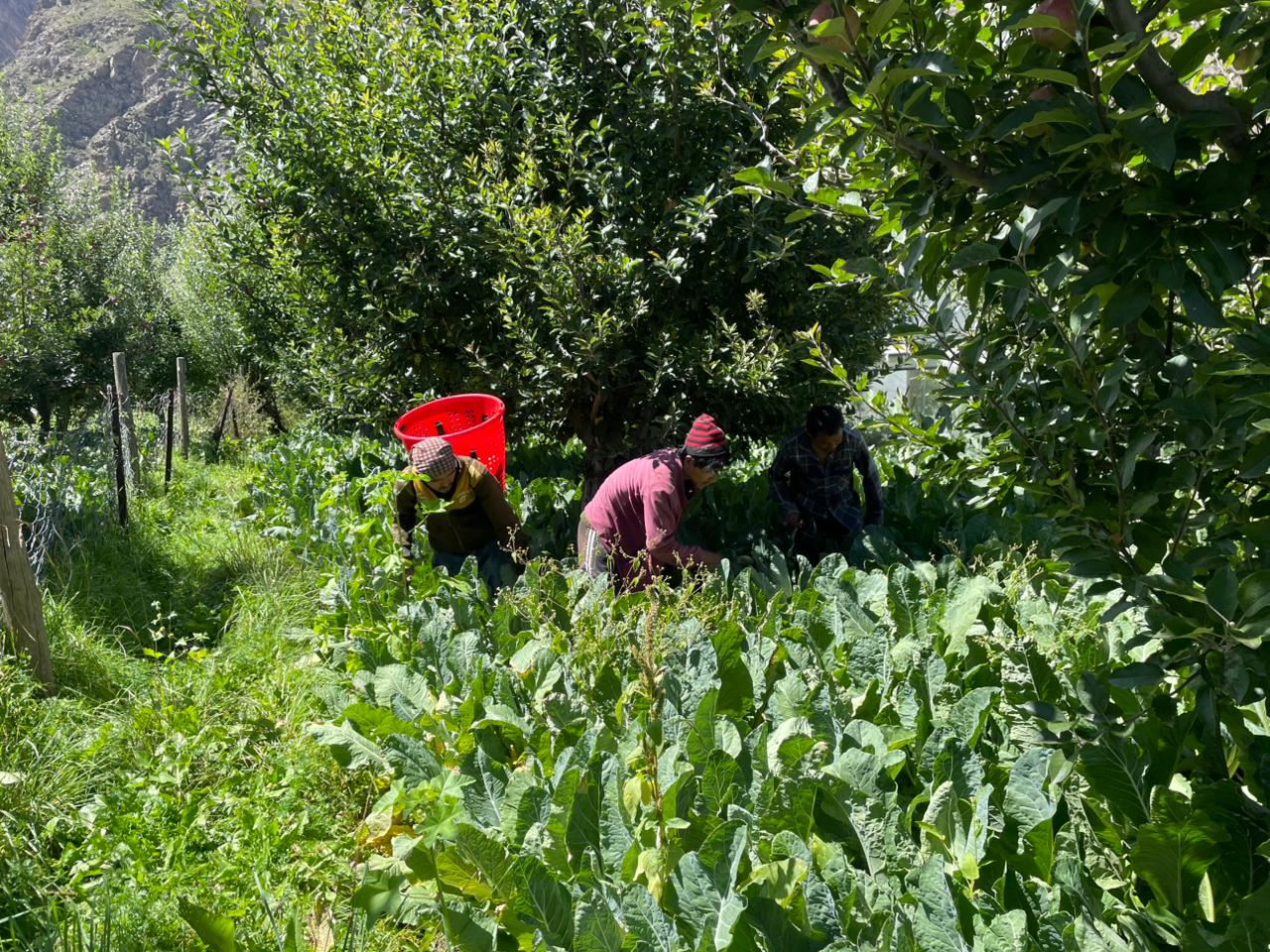
The impact extended beyond local farmers to the hundreds of Nepali labourers who cultivate leased land in Lahaul. Thaman Kumar, who has farmed in the valley for a decade, says this is the first time he’s returning home empty-handed. “Usually, by this time I’ve already sent money to my family for school fees,” he says. “Now I don’t even have enough to clear the loans we took for seeds and transport.”
In addition to vegetables, the apple crop has also been severely affected in the state. Himachal produces up to 4 crore apple boxes annually, with a turnover of Rs. 4000-5000 crore. However, this year, rain and landslides destroyed roads in apple-producing districts like Shimla, Kullu, Mandi, and Kinnaur. In areas like Banjar and Lag Valley in Kullu, apple crops were unable to reach the markets, forcing farmers to abandon their produce. The preliminary estimates reveal losses of up to Rs. 1000 crore for apple farmers in the state.
Also read: Omega-3 fatty acids: The hidden cost of 'health' to our seas
The ripple effects of the monsoon choked the entire supply chain that moves vegetables from Lahaul’s cold desert to the mandis of northern India. Farmers in the region sow in March and harvest begins in early July. Normally, intermediaries called adhtiyas collect vegetables from field-side points and sell them across Himachal and beyond from July to October. This year, however, adverse weather and road closures blocked the Manali–Leh and Chandigarh–Manali highways, forcing drivers to take long, difficult alternative routes and preventing adhtiyas from reaching the valley.
.jpeg)
“Earlier, we could reach Amritsar Mandi from Lahaul overnight,” says Vikas, a pickup driver who ferries vegetables for local traders. “This time, it took us three days. We had to go via Kaza and Shimla, almost doubling the distance—from about 480 to 970 kms. The fare went up from Rs. 16,000 to Rs. 28,000. The roads were so bad we had to repack the crates halfway, sometimes even unload and reload them.”
Perishable vegetables like cabbage, lettuce, and peas rarely survive such long delays. Many shipments that finally reached mandis through alternate routes arrived in semi-spoiled condition, fetching low prices or being rejected altogether. For small farmers who depend on advance payments from traders, these losses have deepened existing debts—burdens they now hope to recover in the next growing season.
During the crisis, the Lahaul and Spiti administration arranged for a limited airlift of vegetables to prevent total losses. Produce from Lahaul was first transported by road via the Bara Lacha–Sarchu–Leh route and then flown to Delhi through air cargo. The process came at a steep cost—around Rs. 150–Rs. 200 per kg for farmers; at one point, the prices of broccoli in Delhi’s markets had spiked to nearly Rs.500 per kilogram during those weeks. In total, about 30 tonnes of vegetables were airlifted from Leh, offering some relief, though only a fraction of the original harvest could be saved.
For small farmers who depend on advance payments from traders, these losses have deepened existing debts—burdens they now hope to recover in the next growing season.
Also read: In Gurugram's rise, a cautionary tale about satellite cities and groundwater
While calamities are not new to Lahaul-Spiti—July 2023 saw similar damage—farmers repeatedly voice the same concern: “What if it happens again next year and we fall deeper into debt? What compensatory support do we have?”
Sanjay Chauhan, a state committee member of the Himachal Apple Growers Association, warns: "If landslides and road blockages keep occurring every year, the state risks losing its position in the agricultural economy. Repeated losses could force farmers to abandon farming altogether in the coming years."
The administration says it is taking steps to support farmers, though challenges remain. According to Dr. Munshi Ram, District Agriculture Officer, teams from the Agriculture and Horticulture Departments, along with ATMA officials, Patwaris, Panchayat Secretaries, and village heads, visited the affected panchayats to assess losses. Reports have been sent to the state government, and compensation is expected to be disbursed according to established standards.
But for many, compensation alone will not address the deeper structural issues exposed by the monsoon. Dr. Ram Lal Markanda, the state’s former Agriculture Minister and a native of Lahaul-Spiti, points out that delays in reopening roads meant much of the relief arrived too late. “More than half the crops were destroyed in the fields,” he says. “Current government schemes, like the Fasal Bima Yojana, are limited in scope—they cover crop loss only within a farmer’s own field and don’t account for losses caused by blocked access or supply chain disruptions. In such situations, farmers are left without adequate support.”
The crucial question is: do we have alternative models and disaster management frameworks that can protect farmers from such recurring shocks? When every landslide and flood doesn’t merely wash away roads and farmland, but also destabilises the incomes of entire families as well as the lives of consumers, the solution will come not from relief packages alone–long-term strategies are crucial.
.jpeg)
According to Dr. Markanda, the current situation in Lahaul-Spiti forces us to reconsider how to safeguard food security and the rural economy in Himalayan states from the growing threat of natural disasters. “Many farmers here lack financial safety nets. Access to tools like the Kisan Credit Card and crop insurance can help them recover from losses and invest in more resilient practices,” he says.
When every landslide and flood doesn’t merely wash away roads and farmland, but also destabilises the incomes of entire families as well as the lives of consumers, the solution will come not from relief packages alone–long-term strategies are crucial.
In the long term, he adds, policies must encourage diversified cropping to reduce reliance on a single harvest, and investment in cold storage infrastructure is essential to preserve perishable produce, limit post-harvest losses, and stabilise market prices. “With landslides and floods striking the Himalayan region with increasing frequency, it is crucial that such robust measures are put in place before the next disaster hits the state.”
Also read: In the battle of Alphonso vs Kesar, climate change plays dirty
{{quiz}}
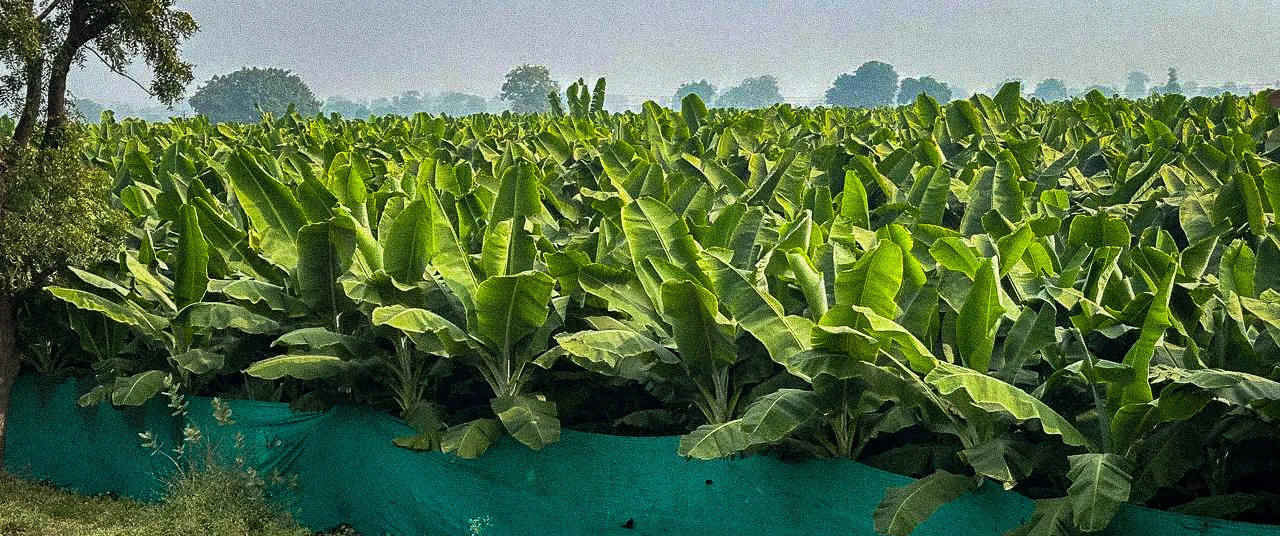
At the heart of Jalgaon’s triumph is Phule Pride, a wind-resistant variety developed locally
The vast, green expanses of Maharashtra’s Jalgaon are a sight to behold. Here, more than 75,000 hectares are draped in banana plantations, securing the region’s reputation as India’s heartland for the fruit. But beneath these lush canopies, growers live with a constant sense of unease: every year, from February to June, roaring storms sweep in, their fierce winds toppling plantations, thrashing broad leaves, and causing devastation through the fields. For many, these storms do more than damage crops—they imperil lives and futures, sowing deep uncertainty among farming families.
The legacy of banana farming in Jalgaon goes back generations. It is a source of pride, learning, and continuity. “We are aware that the crop is fraught with risks, but we continue to grow banana because it runs in the family and we know it so well,” says third-generation grower Vaishali Patil, 46, of Dasnoor village in Raver taluka, who supplements banana cultivation with crops like groundnut, coconut, toor dal and Khapli wheat. “Every May, storms with winds up to 80 km/h devastate plantations,” she says. In 2006, winds flattened her 9-acre crop, resulting in losses of ₹15 lakh-₹20 lakh. Again, in 2015, 6 acres were destroyed, resulting in damages of nearly ₹10 lakhs.
The scale of devastation can be overwhelming. In June 2025, winds and rains ravaged over 3,000 hectares in talukas like Raver, Muktainagar and Chopda, causing losses exceeding ₹30 crore and disrupting the livelihoods of over 1,500 farmers in 93 villages.
This is not isolated; hailstorms, cyclones, and erratic weather cause losses worth crores annually. Despite repeated damage, thousands await compensation for losses dating back to 2019. The crisis deepened in May 2024 when a sudden storm flattened plantations across Raver, Muktainagar, and Bodwad. A three-day 2023 windstorm caused 30%-80% crop loss in affected areas. Delayed and inadequate compensation, despite government surveys, leaves farmers trapped in a cycle of loss without a sustainable safety net.
Imported from Israel to fuel commercial farming, the Grand Naine (G9) banana made its Indian debut in 1995. A high-yielding Cavendish variety with export appeal, it reshaped banana cultivation, particularly in Maharashtra, Tamil Nadu, and Andhra Pradesh, where farmers adopted tissue culture to scale up production. Tissue culture bananas are plants produced through micropropagation techniques in a laboratory setting, using small tissue samples from healthy mother plants. This method allows for rapid, large-scale multiplication of identical, disease-free plants under sterile conditions.
Before that, India’s banana basket brimmed with local diversity—varieties like Robusta, Rasthali, Poovan, Nendran, Red Banana, Monthan, and Safed Velchi, deeply rooted in regional soils and cuisines. With over 300 native types, these indigenous bananas still account for nearly half of India’s production, valued for their flavour, cultural importance, and resilience to local climates. Though Grand Naine dominates commercial plantations, traditional varieties continue to thrive in strongholds across Kerala, Tamil Nadu, Assam, Bihar, and the Northeast, preserving India’s legacy of banana diversity.
With over 300 native types, these indigenous bananas still account for nearly half of India’s production, valued for their flavour, cultural importance, and resilience to local climates.
There has been significant technological advancement with the introduction of tissue culture banana (TCB) plants of G9 , introduced by Jain Irrigation System (JLS) in the late 1980s, with the first commercial plant tissue culture laboratories established around 1987.
Jalgaon’s banana growers utilise both tissue-cultured plants and conventional suckers. TCB banana plants are disease-free, grow uniformly, mature earlier, and yield more compared to conventional suckers, which often carry diseases, show variable growth, and produce lower yields. However, there is a strong push toward TCB due to its economic and agronomic benefits, which are supported by government programmes, such as the National Horticulture Board’s Cluster Development Programme. A central sector scheme launched on May 31, 2021, it aims at the holistic growth and development of identified horticulture clusters to make them globally competitive. It promotes integrated and market-led development of pre-production, production, post-harvest, logistics, branding, and marketing activities in these clusters across India.
Yet, the exclusive use of TCB isn’t yet universal due to cost, infrastructure, and knowledge barriers. Challenges such as scorching temperatures, water scarcity, and intense solar radiation hinder plant establishment and survival.
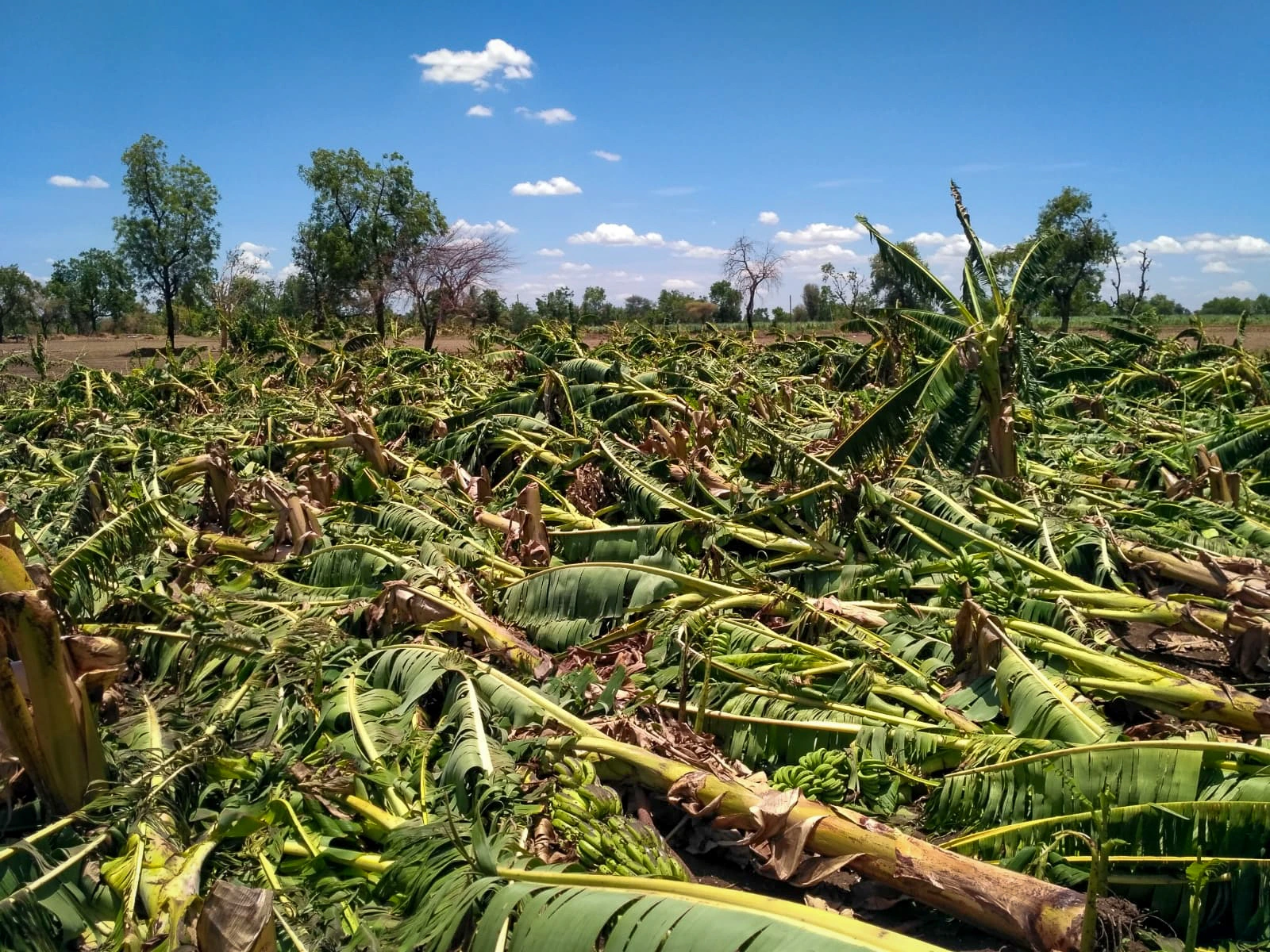
Also read: In the battle of Alphonso vs Kesar, climate change plays dirty
While bananas aren’t typically considered a coastal crop, they are cultivated in the coastal regions of Karnataka, Kerala, and Andhra Pradesh, unlike in Maharashtra, where cultivation is more inland, mostly near the Tapi river. The mineral-rich soils and water availability from the Tapi contribute to making the region highly suitable for banana farming.
In Jalgaon, banana farming is a testament to ingenuity and grit. Cultivators tend to small and mid-sized, often family-run plots where water is a precious resource. In contrast, banana cultivation in South America is conducted on a massive industrial scale, with multinational corporations managing plantations that span hundreds of hectares, primarily for export. The climate there is lush and tropical, with generous rainfall and naturally rich volcanic or alluvial soils, ideal for high-yield varieties like Cavendish. Traditional irrigation and heavy chemical use dominate these landscapes, though some regions are beginning to explore organic and agroforestry alternatives. While Jalgaon specialises in drought-tolerant varieties and moisture-conserving techniques, South America relies on natural abundance and corporate infrastructure.
In Jalgaon, banana farming is a testament to ingenuity and grit. Cultivators tend to small and mid-sized, often family-run plots where water is a precious resource.
Bananas from Jalgaon gained national and global fame primarily after the introduction of drip irrigation in 1989, which significantly boosted production and yield despite the region’s low rainfall. High-density planting helps conserve moisture, creating a humid microclimate that enables bananas to flourish even in dry conditions. Since then, Jalgaon has become the world's seventh-largest banana producer, known as the "Banana City of India," and its bananas are widely exported across India and internationally. The Jalgaon banana also received a Geographical Indication (GI) tag in 2016, giving it legal protection and unique identity, further boosting its status.
Its success is credited to these innovations, especially among the Gurjar and Leva Patil communities—migrant communities who have had a long-standing presence in the region.
Dr. B. K. Patil, who has worked with JIS for several decades now, has played a key role in advancing banana cultivation and tissue culture technology in India. Patil points to a key difference: “Banana cultivation in Jalgaon follows a non-perennial cycle, because after harvesting the main crop and one ratoon crop, yields and plant health decline, and disease risk increases, so farmers clear and replant the land to maintain productivity and sustainability.”
Also read: How lemon groves turned Manipur’s Kachai into a citrus empire
Wind poses a constant threat; with wide, sail-like leaves, banana plants are especially vulnerable—strong gusts can snap stems or topple entire clusters. Research at Jalgaon’s Banana Research Station shows storms reduce yields and increase vulnerability to disease. Vinod Borse has witnessed the destructive force of storms firsthand. A progressive farmer from Pichardi village and president of Shri Girnikat Shetkari Utpadak Sangh (an organisation that supports farmers by promoting collective action, sharing agricultural knowledge, and advocating for better market access and farming practices), he notes gusts often affect a 1.5-km radius, damaging plantations across several talukas.
To counter this, Borse pioneered innovations such as ratoon cropping, high-density planting (8x5 feet spacing), organic waste mulching, and advanced bunch management techniques, including covering, thinning, and denavelling (removing young male buds) in 2020. He uses a low-cost fertiliser schedule and other practical adaptations that enhance yield, fruit quality, and sustainability. Through workshops and digital platforms, he shares these methods widely.
With wide, sail-like leaves, banana plants are especially vulnerable—strong gusts can snap stems or topple entire clusters.
“When I first introduced 3-foot-wide raised beds between rows, with soil heights of one and two feet, people laughed,” Borse recalls. “But today, 20 farmers in my group have adopted the practice, which now covers 300 acres. It protects plants from strong winds and improves fruit quality.”
With expert guidance, Borse cultivates bananas in two cycles on his eight acres, achieving yields up to 30 tonnes per acre. His export-grade bananas fetch ₹18-₹29 per kg, attracting direct visits from traders. In 2023, he founded the Girana-Kath Farmers’ Producer Company, which consists of 300 members. Beside installing pack houses for farmers, he shares his innovations on his YouTube channel, ‘Experimental Farmer Vinod Borse’.
Premanand Hari Mahajan, a prominent farmer from Tandalwadi village, farms bananas on 50 of his 80 acres of land using drip irrigation, high-density planting (1,200-1,500 plants per acre), and tissue-cultured Grand Naine plants. These methods save 60%-70% water and yield among the highest in the world—about 53 tonnes per acre. Mahajan’s cultivation cost is ₹1.1 lakh–₹1.15 lakh per acre per season with good profit margins, selling bananas at around ₹500 per quintal. To protect against strong winds, he planted Nirgundi (Vitex negundo Linn.): nirgundi is grown primarily for its natural pest-repellent properties and as a bio-fence to protect banana crops from pests and diseases. It also helps in reducing soil erosion, improving biodiversity, and providing additional income through the sale of its leaves and medicinal extracts. Tellingly, Mahajan’s bananas have been exported to Iran and Iraq.
Dr Arun Bhosale, a horticulturist at Jalgaon’s Banana Research Station, recommends live fencing with tall species—such as Sesbania sesban—planted two metres from the banana rows. Shade nets offer additional protection, and a planting density of 1.5 x 1.5 metres reduces lodging and improves airflow.
In recent years, farmers have developed layered defences: windbreaks of bamboo, native trees, or permeable barriers, such as nets, reduce wind speed. In places without natural windbreaks, plastic sheets or mesh allow gentle airflow and prevent turbulence. Bamboo stakes tied in clusters support plants by distributing wind pressure, while ropes secure bunches to reduce swaying and uprooting. Plantation layouts shifted from long rows to block planting, sometimes with maize or other sturdy crops as buffers. Choosing sites near hills or forests adds resilience. Mobile weather alerts provide timely warnings.
In Jalgaon, many plantations face a hidden challenge: the hardpan, a compacted soil layer that restricts root growth and water movement. Vaibhav Suryawanshi, subject specialist at Jalgoan’s Krishi Vigyan Kendra, recommends subsoiling as an effective remedy. This deep tillage, done every 2-3 years, breaks through the hardpan without disturbing topsoil. “Subsoiling improves soil structure, boosts fertility, enhances drainage, and increases microbial activity,” he explains. “It also reduces erosion and waterlogging, leading to better crop yields and economic returns.”
Determination grows, as farmers move beyond helplessness to resilience, aiming to build strength into every new planting.
Studies in 2017 revealed soaring production costs as the top challenge, followed by natural events, pests, and labour shortages. Traders and middlemen pressure margins further, increasing stress on households. Insurance coverage increased, with nearly 72,000 banana farmers in Jalgaon signing weather-linked crop insurance for 2024-25, according to the Economic Survey of Maharashtra 2024-25. However, compensation remains caught in bureaucratic delays, highlighting the need for systemic reform.
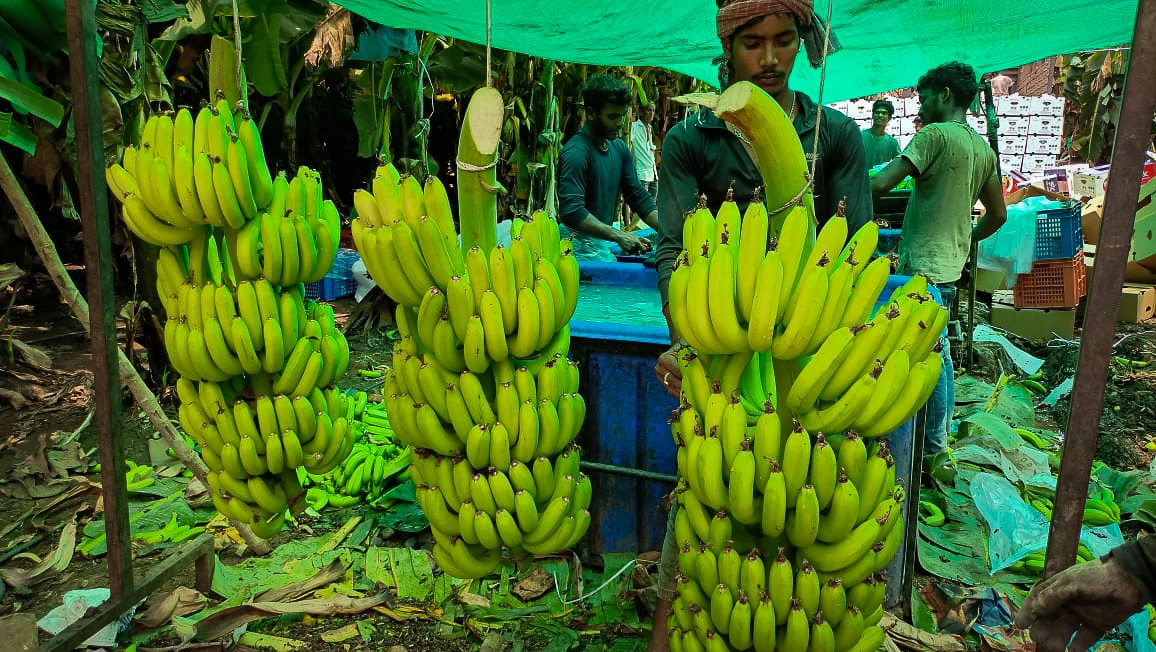
A 2023 study published in the International Journal of Research in Engineering, IT and Social Sciences states that economic shifts have made farming less attractive for the next generation; fewer families rely on it as their sole livelihood, and across the district, the educated sons and daughters of farmers are looking to cities or low-wage jobs for steadier pay. Still, most banana growers are university graduates, deeply invested in ancestral land, and many endure, working on small plots but earning more than ₹2.5 lakh a year. They persist against mounting climate uncertainty, rising costs, erratic markets, and bouts of crop disease and pest damage.
For years, Suresh Patel, a farmer from the neighbouring district of Nandurbar, would watch in horror as up to 80% of his plantation was flattened in a single night. But everything changed in 2025, when Suresh embraced Phule Pride—a wind-resistant variety developed locally—and paired it with smarter farming practices. Using cluster staking, lines of bamboo as windbreaks, and mobile weather alerts from his cooperative, Patel not only preserved his crop during the March storms but also managed to harvest 20% more than before.
The Phule Pride variety was born out of seven years of research at the local Banana Research Centre and has been field-tested since 2018. Unlike its globally dominant parent Grand Naine, Phule Pride stands a little shorter, its stems thick and resolute. It doesn’t just survive wind—it thrives, shrugging off lodging, resisting the fatal fungal disease of Sigatoka leaf spot, and maturing almost a month earlier than rivals. Although its yield (98 tonnes per hectare) trails Grand Naine by a whisker (which averages 110 tonnes), Phule Pride promises a complete harvest; every bunch makes it to the market, and cultivation costs stay low. The result: higher net returns and a farm that’s storm-ready.
The Phule Pride variety was born out of seven years of research at the local Banana Research Centre and has been field-tested since 2018.
Since 2021, tissue culture labs in Maharashtra have been successfully meeting the growing demand for its saplings among farmers. Progressive young farmers like Hitesh Mahajan in Raver couple it with summer-savvy practices—mulching, reinforced pits, clever intercropping—to safeguard every plant through the most punishing months.
“From staggered planting to post-harvest innovation that transforms even rejected bananas into profit, we’re equipping farmers to not just grow more, but earn more. India must lead not only in production, but in global banana exports, with trained, organised growers capturing full value from every fruit,” emphasises Dr Patil.
A quiet transformation spreads across Khandesh. As intensive banana planting grows, farmers also sell tubers for extra income. The demand for high-yield seedlings now outpaces large-scale supply efforts for both Kandebag and Mrig Bahar seasons. Nearly half the district’s banana acreage is under intensive systems, double from a few years ago, signalling that Jalgaon’s moment as India’s banana capital continues. Modern varieties, smart agronomy, and community cooperation point the way ahead, even as challenges remain.
Also read: Syed Ghani Khan’s orchards guard mango treasures from Tipu Sultan’s reign
{{quiz}}
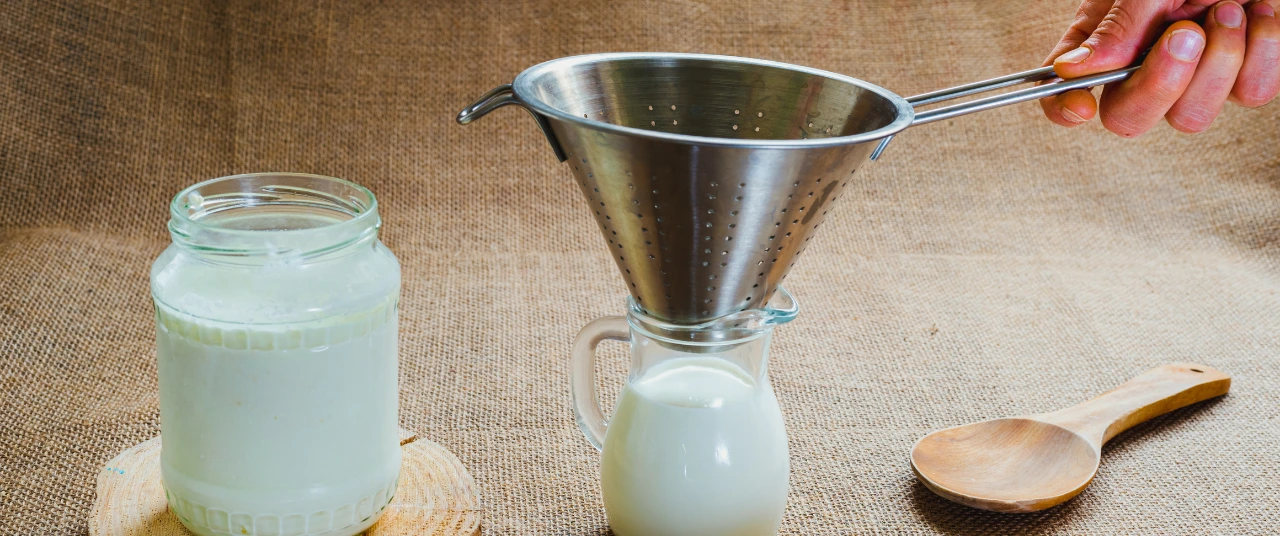
High-protein milk simply concentrates the full range of proteins naturally present in milk
Editor's Note: From grocery lists, to fitness priorities, and even healthy snacking, protein is everywhere—but do we truly understand it? In this series, the Good Food Movement breaks down the science behind this vital macronutrient and its value to the human body.
For many of us, the word ‘high-protein’ conjures up images of shaker bottles, supplements, or even tubs of whey powder. But in the past few years, supermarket shelves have introduced another option: high-protein milk. It looks like regular milk, tastes like regular milk, and yet somehow promises nearly double the protein. This has naturally led to the assumption that high protein milk must be fortified with whey powder. Whey is the watery liquid left over when milk curdles, and the solids (curds) are strained out; whey powder, the concentrated protein extracted from this liquid has, in turn, become synonymous with gym culture and quick protein hits.
But high-protein milk is built on a very different principle, one that preserves the pre-existing balance of proteins found in milk rather than isolating and concentrating only one part of it. Instead of adding isolated whey proteins, which would change both its taste and the way our bodies may digest it, high-protein milk simply concentrates the full range of proteins naturally present in milk.
To understand this distinction, it helps to look at what milk contains. Cow’s milk carries two main proteins: casein and whey. Casein makes up the majority of this content, forming microscopic structures called micelles that stay suspended in milk. Whey makes up the remaining fraction and stays dissolved in the liquid.
This difference sets up the key contrast between proteins that remain blended in this manner (like those found in milk, where casein and whey co-exist) and isolated proteins (like whey powder, which extracts and concentrates only the whey fraction from milk). Blended proteins are digested across different speeds and durations; isolated proteins act quickly and intensely.
Also read: Whey to go: A complete guide to protein
High-protein milk keeps this natural casein–whey blend intact. Instead of adding isolated protein, producers run fresh milk through a process called ultrafiltration. Think of it as a very fine sieve: water, lactose, and some minerals pass through, while the larger molecules of casein and whey stay behind. When the retained portion is recombined, you end up with milk that has more protein per millilitre and a higher calcium concentration (calcium is bound to casein micelles, which the process of ultrafiltration retains). Meanwhile, it keeps the original casein-to-whey ratio more or less intact.
This is the crucial distinction. Whey powder also uses ultrafiltration, much to the same degree. However, in contrast to high-protein milk, where ultrafiltration is applied to whole, fresh milk, only the whey liquid, where casein has already been removed in the curds, is subject to this process in the making of whey powder. Hence, unlike whey powder, which strips away the casein and delivers only the fast-acting part of milk’s protein, high-protein milk makes denser the full protein profile naturally present in the milk.
High-protein milk, by retaining this natural blend and simply concentrating it, supports both immediate recovery and longer-term maintenance,
This matters because the human body responds differently to blended proteins than to isolated ones. Whey is rapidly digested. So when you consume whey—an isolated protein—alone, you get a sharp, immediate rise in amino acids. This is excellent after a workout, when your muscle tissue is primed to repair itself. But that benefit lasts only for a limited window.
Meanwhile, casein digests slowly because it forms a soft curd in the stomach, giving a prolonged, steady release of amino acids. With its slow-release, casein stretches this window out. This is why research often describes the natural combination of casein and whey found in milk as offering both a ‘burst’ and a ‘supply line’ of amino acids. High-protein milk, by retaining this natural blend and simply concentrating it, supports both immediate recovery and longer-term maintenance, making it useful for people who want to tailor their protein intake to not just to workouts, but also to the long-term strengthening and functioning of the body—like steadier blood pressure, boosted immunity and bone development.
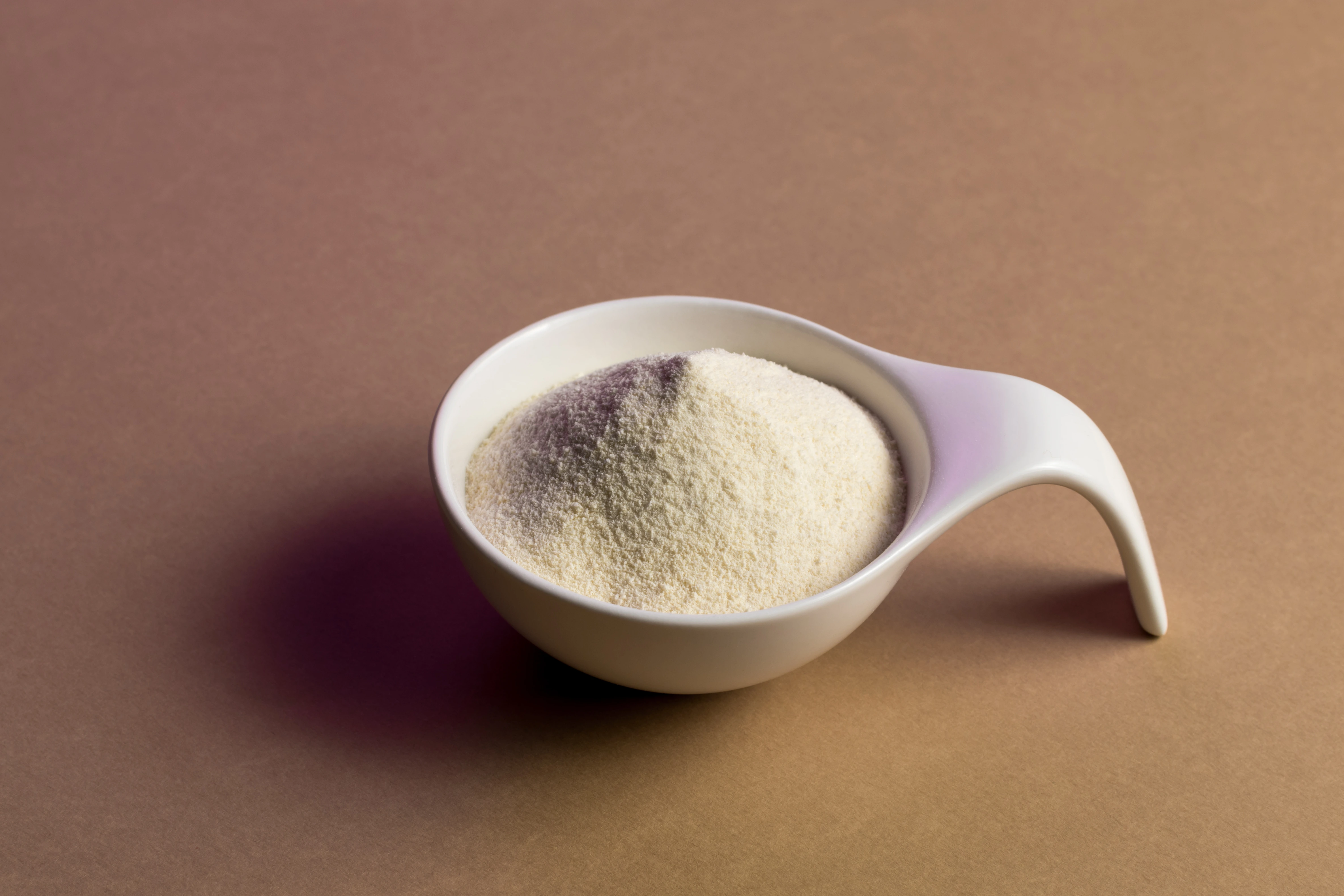
Also read: Protein traceability: Why knowing where your milk and pulses come from matters
When evaluating these two sources of protein, there’s also the question of how the body uses this nutrient throughout the day. The broader science around muscle protein synthesis (MPS) indicates that our muscles respond best when we give them moderate amounts of high-quality protein at regular intervals. Since high-protein milk behaves like milk—just denser—it can be slotted naturally into meals and snacks without taking a supplement. In practical terms, this makes it easier to distribute protein intake across breakfast, lunch, and dinner, a strategy that supports better synthesis and reduces the peaks and troughs that come with having most of our protein during the heavier meals of lunch and dinner.
High-protein milk, however, also has its limitations. Since it’s still milk, it retains lactose unless the manufacturer removes it separately—making it unsuitable for people with lactose intolerance. And while it offers more protein per serving than regular milk, it can’t match the sheer density of whey isolate, which is designed for people who need a large protein dose without extra fluid, fat, or carbohydrates. Its value lies elsewhere: as a whole-food, everyday option that fits naturally into the diet without leaning on supplement logic.
In the landscape of high-protein eating, it is easy to collapse all protein sources into the same bucket. But understanding the difference between high-protein milk and whey powders reminds us that how protein is delivered is as important as how much of it we consume. One is a concentrated version of a food we already understand; the other is a targeted supplement engineered for speed and a low protein-to-calorie ratio. Both have their place, but if your goal is to eat more protein embedded into your natural diet—with a balance that supports sustained recovery, fullness, and steady muscle maintenance—high-protein milk may fare better for your body.
Also read: The ‘right time’ to eat protein: Little and often, rather than in one meal

As bees, moths and flies make a quiet exit, their absence will directly impact crop resilience and yield quality
Editor's Note: The planet we inherited as children is not the planet we will someday bid goodbye to. The orchestral call of cicadas in the evenings, the coinciding arrival of the monsoon with the start of the school year, and the predictability of natural cycles—things we thought to be unchanging are now at risk. An altered climate, declining biodiversity and warming oceans aren’t distant realities presented in news headlines; they affect us all in seen and unseen ways. In ‘Converging Currents’, marine conservationist and science communicator Phalguni Ranjan explores how the fine threads connecting people and nature are transforming with a changing planet.
Think back to when you were a kid. Do you remember tiny bugs sticking to your t-shirt when you played outside, just as dusk creeped in? Or tiny, black bugs splattering an abstract painting on the windshield of your parents’ car?
Can you recall when they began to vanish, from our clothes and the walls of our homes?
Think of a world without insects. No buzzing bees, fluttering butterflies, or industrious beetles. It sounds improbable—insects are the most abundant group of animals on Earth—but it is happening. We do not notice it until one day, we suddenly realise that the windshield has been bug-free for far too long.
I remember an abundance of fireflies, noisy cicadas, different kinds of ladybird beetles, and many beehives from my childhood—all of which seem to be vanishing, now.
But what does that mean for us?
The Earth is home to an estimated 8.7 million species of animals and plants, and insects make up around 80% of that figure! Sadly, around 40% of all insects are at risk of extinction, not counting those that are already lost to science and us. A study recorded a 76% decline in flying insect biomass in Germany’s protected nature areas over 27 years, sparking global concern over insect declines and a possible ‘ecological Armageddon’.
Insect pollination supports nearly 75% of global food crops to a great extent, though only around 35% of production (by volume) depends on pollination. However, insect-pollinated crops tend to have higher yield, quality and nutrient content, making them financially and nutritionally more important, especially in developing nations.
Without insect pollinators, certain staples like wheat, rice, and maize would still grow, but a wide variety of fruits, vegetables, nuts, and seeds would suffer, reducing yields by about 5% in high-income countries and 8-10% in low-to-middle-income countries.
Interestingly, 40% of the global nutrient supply comes from animal-pollinated crops, insects included. We could lose many crops for fibre, fodder, dietary supplements, timber, and of course, food. A 100% loss of pollinators could reduce global supply of fruits by 22.9%, vegetables by 16.3%, and nuts and seeds by 22.1%, threatening food security, worsening nutrient deficiencies, and destabilising ecosystems—a process already underway.
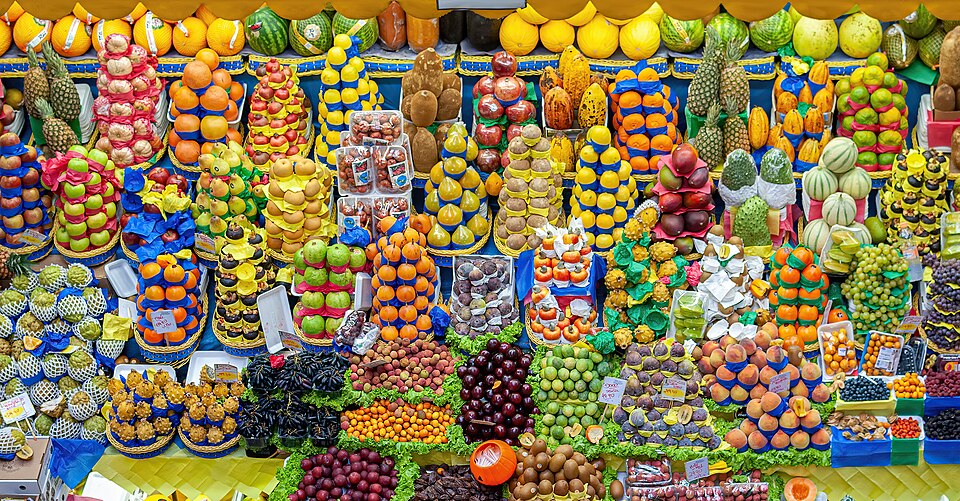
The consequences go well beyond food. These tiny critters—especially the helpful, non-pest species—play a critical role in several ecosystem processes like soil formation, nutrient cycling, decomposition, and biological pest control; all vital for agriculture and the ecosystem. Insects also form the base of the food web for several smaller animals and their declines can further drive bird, amphibian, and small reptile declines—essentially anything that feeds on insects.
Without insect pollinators, certain staples like wheat, rice, and maize would still grow, but a wide variety of fruits, vegetables, nuts, and seeds would suffer, reducing yields by about 5% in high-income countries and 8-10% in low-to-middle-income countries.
Pollinators, especially insects, in India are under pressure from multiple directions. Recent surveys show that bees are not the only insects under threat. The iconic fireflies have declined by 76% across the country, and eight species of dragonflies have gone locally extinct in the Western Ghats in Maharashtra. Observations also suggest several species of flea beetles, longhorn beetles, and damselflies have been lost to science in the last few decades, but a lack of comprehensive data makes it difficult to track these declines accurately.
Widespread, indiscriminate pesticide use is one of the biggest threats to these insects, with neonicotinoid (or neonics) pesticides standing out as major culprits. Neonics make up around 40% of the global pesticides market. While they are more effective as pesticides, they linger in water and soil; they are also toxic to the small animals that feed on insects.

Widespread, indiscriminate pesticide use is one of the biggest threats to these insects, with neonicotinoid (or neonics) pesticides standing out as major culprits.
Pollinators also face mounting pressure from habitat loss due to expanding commercial farms, cities, and deforestation. Climate change further disrupts the timing of flowering and pollinator activity. Stresses from invasive species, transgenic crops (with artificially introduced foreign genes), diseases, pollution, and urban light disturbance add to the problem. Urban light pollution is caused by the excessive use of bright artificial light at night that interferes with the natural rhythms of birds, insects, and even humans, causing confusion, disorientation, and sometimes disrupting natural migration pathways.
Also read: No monkeying around on this kiwi farm
India is a predominantly agrarian country, with agriculture supporting the livelihoods of over 42% of our population and contributing over 18% to the GDP. Naturally, this makes the decline of pollinators a serious concern for productivity, livelihoods, and food security.
The country’s rich pollinator biodiversity—over 700 bee species along with several more butterflies, moths, and flies—is vital for crop and forest pollination. Their declining numbers will lead to lower and poorer quality yields, higher labour costs for manual pollination, and weakened crop resilience. Nutritionally, reduced availability of micronutrient-rich foods like fruits, vegetables, and nuts can worsen hidden hunger through micronutrient deficiencies, with major implications for public health.
Fruits, oil seeds, fibres (like cotton), vegetables, ornamental plants, condiments and spices all depend on pollinators. In 2017, insect pollination contributed around USD 22.5 billion or Rs. 1,12,615.7 crore to India’s agroeconomy—a figure that has likely risen since.
However, the problem is much more nuanced. Growing food demand drives the use of more pesticides, fertilisers, and fungicides to increase yield. Land conversion for aggressive agriculture and a push to capitalise on cash crops further reduces habitat diversity and availability. Though these inputs raise yields in the short term, pollinators pay the price in the long run, with compounding toxicity and habitat loss. Climate change-related seasonal irregularity adds another complication. In nature, periodically occurring biological events like flowering and reproduction depend on environmental factors like temperature and light duration. Climate change is disrupting regular seasonal and climatic patterns, and the pollinators are unable to synchronise their arrival with the shifting flowering periods—a phenomenon called phenological mismatch.
Ideally, we need to shift toward farming practices that not only sustain production and livelihoods, but also protect biodiversity. While there is much to learn from global examples, India’s unique challenges—shaped by population, climate, geography, and socio-economics—mean that solutions must be tailored locally.
For most of us, insect decline is a reality we are comfortably buffered from. However, for farmers, it is starker and gloomier—it is a question of their livelihoods. Bee declines in Uttarakhand have pushed farmers to use artificial pheromones in their apple orchards in a desperate bid to attract bees. While manual (or physical) pollination exists, it is labour and time-intensive, and not always a logistically viable option. Across the world and in India, farmers are now renting bees from beekeepers for assisted pollination—a very lucrative and growing business for beekeepers, but one that might make affordability a problem for small-scale farmers. Now, new-age robot-assisted and drone technologies are also being explored to boost pollination, but these still remain in the development stage, with operational constraints.
The United Nations Environment Programme (UNEP) advocates for food systems that work with nature for more resilience, as agriculture is likely to be severely impacted by climate change. Evidence from some Indian farms echoes this, showing that nature-aligned and biodiversity-focused practices can restore insect populations while maintaining healthy yields.
Across the world and in India, farmers are now renting bees from beekeepers for assisted pollination—a very lucrative and growing business for beekeepers, but one that might make affordability a problem for small-scale farmers.
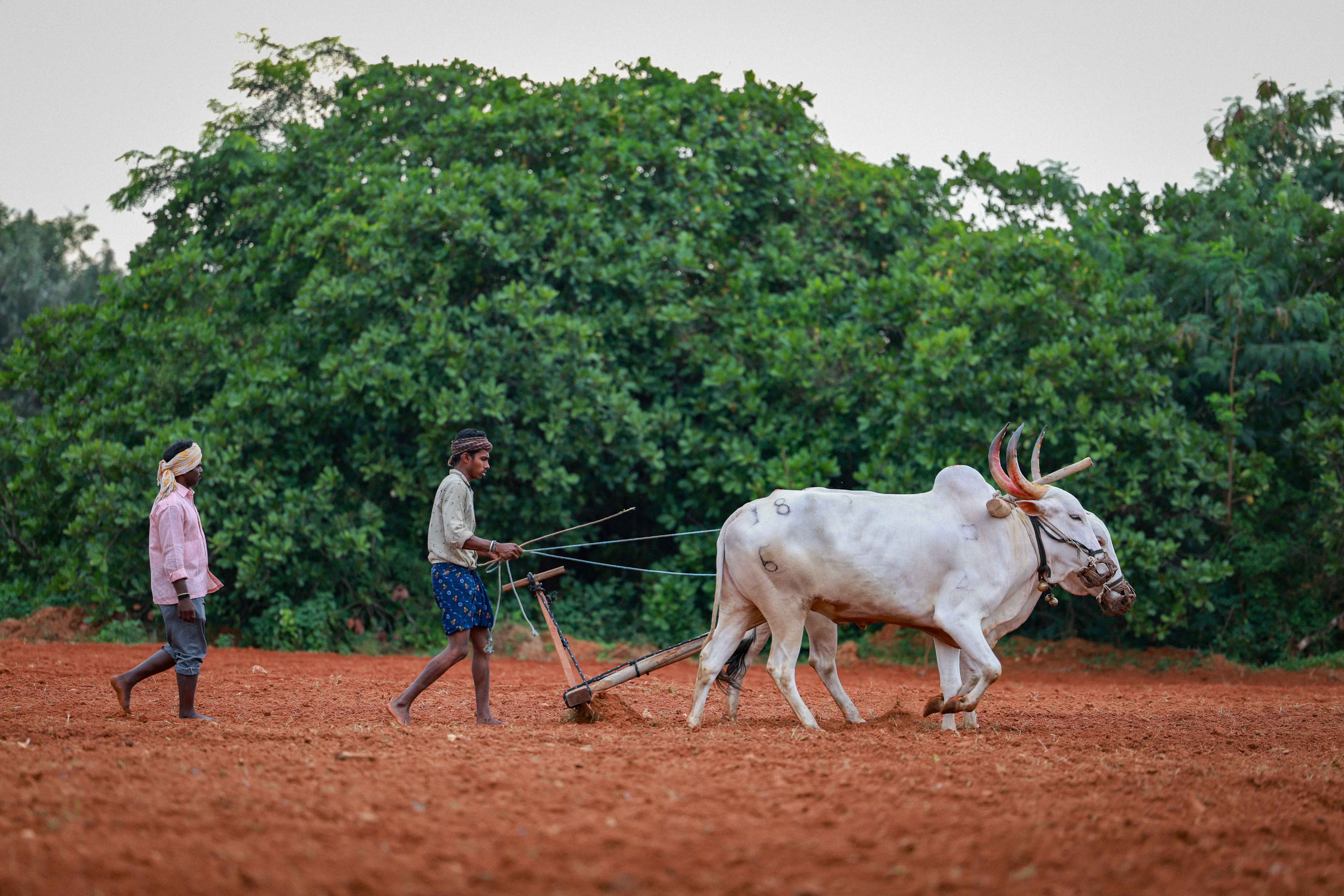
Zero-budget natural farming (ZBNF) is a grassroots agroecological farming method that avoids synthetic fertilisers and pesticides. Instead, the process promotes the use of natural inputs and mulching to improve soil health, increase yields, and reduce farmers’ costs. Research shows that ZBNF has improved yields on several farms in Karnataka and Andhra Pradesh, with notable gains in crops such as rice, chilli, and cotton, while reducing production costs. These farms were also found to support 30-50% higher insect species richness (large numbers and large diversity), including 2-3 times more pollinator species and natural predators, while boosting the farms’ resilience to climate shocks, when compared to chemical-based farms.
Building on ZBNF, the Andhra Pradesh Community Managed Natural Farming (APCNF) movement promotes nature-based farming by integrating livestock, organic residues, plant-based pest control, and crop diversification. Farmers also install bird perches and crop border strips, enhancing habitat for pollinators and birds. Compared to chemical farms, these fields show healthier soils, with observations noting the return of birds to the landscape.
Also read: Farming under the elephant's nose: Lessons in crop choices
Change is possible. Organic farming is catching on in India; Sikkim was declared the world’s first all-organic state in 2016, having phased out chemical pesticides, fertilisers, and GMOs completely. Farmers across West Bengal, Karnataka, and Andhra Pradesh are adopting nature-integrated agricultural practices to restore soil health, and boost food security and climate resilience while preserving biodiversity. Such nature-aligned farming practices can help boost pollinator numbers by reducing toxic pesticides, and increasing availability of more diverse and healthier crops (and thus, pollen and food).
However, widespread adoption requires training, funding, and policy support. We need more robust science, collaborative action, and stronger policies to fuel community-based initiatives that bring farmers, scientists, and policymakers together.
There are small things we can do as well. Urban light pollution causes significant disturbances to insects’ circadian rhythms and nocturnal migrations, and swapping out blue lights (which can affect people too) for warmer and softer yellow lights can help.
Protecting pollinators is not just about saving insects or preserving biodiversity. It is finding a solution to a complex multi-level problem; one that involves our food, economy, livelihoods, and the resilience of the ecosystems we all depend on.
Artwork by Radha Pennathur, Communication Designer & Illustrator
{{quiz}}
.png)
From earthworms to dung beetles, the agricultural landscape and its thriving soil features a diverse set of agents
Editor’s note: To know Rama Ranee is to learn about the power of regenerative practices. The yoga therapist, author and biodynamic farmer spent three decades restoring land in Karnataka, envisioning it as a forest farm in harmony with nature. In ‘The Anemane Dispatch’, a monthly column, she shares tales from the fields, reflections on the realities of farming in an unusual terrain, and stories about local ecology gathered through observation, bird watching—and being.
A freshly dug up mud bank where wild pigs foraged for tubers on their nightly jaunts; burrows under the compost heap where a slinking mongoose sought earthworms; the barely perceptible rustling under a heap of fallen leaves and the scurry of tiny roaches and millipedes—all of it makes the soil what it is, a matrix where substance and processes are indistinguishable.
Living soil is a complex world of decomposed organic matter, a host of micro- and macro-organisms, bacteria, fungi, nematodes (a free-living worm of the phylum Nematoda), worms, insects and rhizosphere (the volume of soil in proximity to root segments). This dynamic universe is brought alive by their interactions. Occasionally, if we choose to lower our gaze, terra firma’s curtains rise, revealing actors who—for the most time—remain backstage, or to be precise, underground.
Also read: Farming under the elephant's nose: Lessons in crop choices
A large snail shell tottered down a slight slope, almost as if it had a life of its own. That it was a perfectly empty shell devoid of all signs of life was intriguing. It must have belonged to a long dead Giant African Snail but was now being repurposed by an ingenious Dung Beetle. The shell was two inches big, and the beetle less than one-fourth its size, explaining the struggle to get it across to I-don’t-know-where; half-dragging, half-pushing into a semi-roll, in a heroic effort.
After a lapse of 15 minutes, the bug and the snail shell had made foot-long progress, and this time, the direction had changed. Instead of down the slope, it was up! When I came back to the spot after an hour the project had been abandoned, the shell lying by the wayside, unclaimed.
Dung Beetles are a treat to watch. When they find fresh cow dung, they roll bits of it away towards their nests in tunnels as brood balls, where eggs are laid and young ones raised. The adults feed on the moist, nutrient-rich contents, while the larvae hatch and feed on the fibrous residue, ingesting the coarse, undigested plant material populated with bacteria and fungi. Elephant dung, too, is much coveted by these beetles.
Dung Beetles are a treat to watch. When they find fresh cow dung, they roll bits of it away towards their nests in tunnels as brood balls, where eggs are laid and young ones raised.
It is evident that Dung Beetles contribute to the health of the soil as primary decomposers—recycling nutrients, improving soil structure and water retention. Their tunneling aids aeration and water percolation. By consuming fresh dung efficiently, they prevent pests like dung flies from multiplying, a natural pest control measure. Another important role is that of secondary seed dispersers; they bury seeds and save them.
I have acquired a perpetual crick in the neck while walking, as I watch out for ant armies marching in the grass. Tree trunks, bamboo clumps, leafy branches, stems of plants, in the ground, and of course, in the kitchen—they are everywhere. These ubiquitous beings have a deep connection with the soil; those who dwell in it are essential shapers of its quality and health.
Recently when the sun shone bright, after a rainy spell, little Black Ants were tunnelling, lifting granules of grit, and placing them precisely around the periphery. Another team of ants garnered seeds of amaranth from the ground—remnants of a harvest. After a while, a mound grew with a fine lining of amaranth seed hull discarded from the tunnel. The tiny seeds had been expertly hulled and stored away for the future. No wonder Black Ants are revered by our farming community.
Marvelling at the ants, farmhand Rajappa shared a story as narrated by his father: there was once a terrible drought where farmers lost all their crops. Even the hardiest ragi withered in the fields. Finally, when the clouds gathered and the rains came pouring down, the farmers tilled their fields. To their utter dismay, no one had a grain of ragi to sow! Despair turned to wonder when armies of black ants emerged from their tunnels with perfectly preserved grains and heaped them onto the fields, for the farmers to sow. Since that day, they are revered as farmers’ saviours with offerings of rice. Every morning, Nagarajappa—our cattle vaidya can be seen making his offerings to the Black Ant.
Their presence in the soil is beneficial in many ways, from the control of potential insect pests like beetle grubs and termite larvae by predation, to inhibiting pathogens by scavenging dead organic matter including carcasses and fruits.
The industriousness of Little Black Ants (Monomorium minimum) is upheld as an example to impressionable young children through fables like Aesop’s The Ant and the Grasshopper. Their foraging behaviour is ecologically significant, contributing to the dispersal of seeds of wild plants. We have found that the propagation of most wild edible greens is best left to nature, but how these delicate seeds endured harsh weather was a mystery. We apparently owe their survival to the Little Black Ant!

A decade ago, before the ground became a mantle of grass, ant columns and nests were visible. The lemon trees were beginning to bloom, but the floor in the interspaces was bare and dry. As if marking the centre was a neat, elevated mound of tiny pebbles and feathers belonging to slender greyish ants in a subterranean nest. I had, in all probability, come upon the nest of the Sri Lanka queenless ant (Diacamma ceylonense), common to our island neighbour and south India.
The Bannerghatta National Park with its deciduous forests, where the Anemane Farm is located, is home to this soil-dwelling ant specie known to use feathers around its nest. The feathers are a decoration with a purpose: to trap dew for water supply, as a camouflage to conceal the entrance, and as a protective barrier from predators.
Their presence in the soil is beneficial in many ways, from the control of potential insect pests like beetle grubs and termite larvae by predation, to inhibiting pathogens by scavenging dead organic matter including carcasses and fruits.
Though two species are mentioned here, there are several others whose identity I cannot establish. A study of the adjoining area indicates a significant diversity. The ecological importance of soil-dwelling ants is immense:
· Balancing insect populations, which are potential pests, ensures soil health
· Their antimicrobial secretions inhibit soil pathogens, maintaining a hygienic environment around the nest
· Their tunnels are repositories of nutrient-rich organic material which, upon decomposing, enriches the soil
· The constant moving and mixing of soil particles from different depths improves soil texture and fertility
· The underground galleries create pockets which aid aeration and water drainage
· Seed dispersal occurs through mutualism (myrmecochory, or a seed carrying partnership) between the plant and ant
· Seeds with nutrient-rich structures (elaiosomes) that are an attractive food source, are collected. After consuming the protein-rich, fleshy parts, the seeds are disposed in nutrient-rich soil where they may germinate.
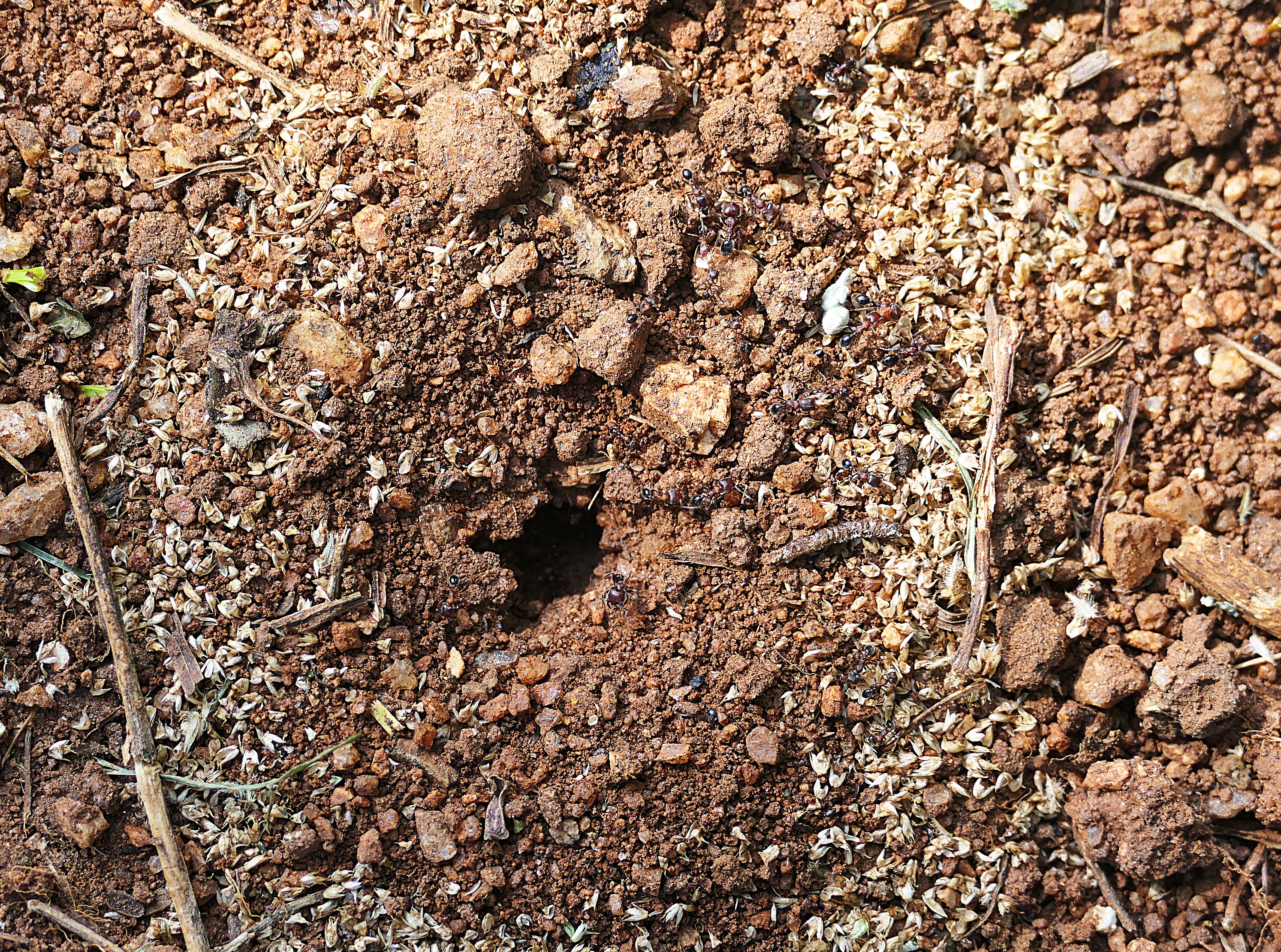
Also read: How birds open a window to the shared web of life: our ecosystem
Often dreaded for their uncanny ability to find and destroy wood or anything else with cellulose, termites are both, a threat and a blessing, depending on the situation and whether we are in the thick of it ourselves. Not merely trees or vegetation, but even human habitation—especially mud-plastered walls, wooden beams, any ‘untreated’ wooden surfaces, fabric, and paper—is under risk in some environments.
The redeeming fact is that termites are attracted to dead or decaying wood, including trees affected by decay fungi. A healthy tree may stand untouched and unaffected amid termite infestation. A tree may be stripped off its decayed bark, dead limbs and heartwood and continue to thrive, if part of the sapwood and cambium—the living tissues—are intact, as has been the case with one of our citrus and Jamun trees. Recycling nutrients through the decomposition of lignin, one of the toughest natural materials to breakdown, is a vital ecological service provided by termites. As ecosystem engineers, they create fertile islands of enriched soil by digesting and redepositing soil particles combined with decomposed organic debris. Termite ‘reconstituted’ soil is rich in organic carbon, nitrogen, and phosphorus.
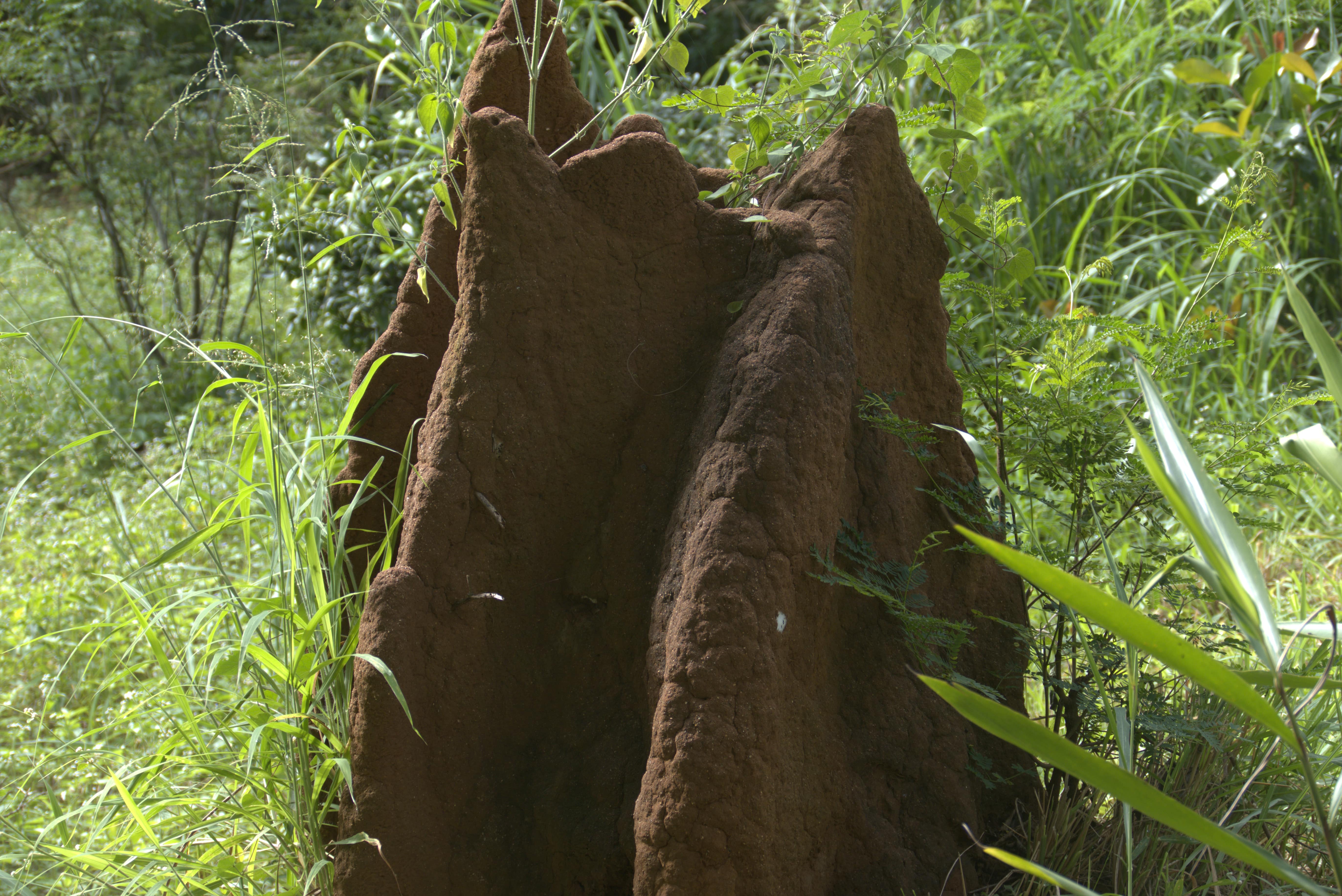
Subterranean termites which build cathedral-like mounds (species of Termitidae) shape soil hydrology. The mounds are connected by a labyrinth of underground tunnels and complex galleries, creating spaces that aid the percolation of water. Traditionally, mound sites were considered as indicators of potential water sources, but exploitation of deep aquifers may have disturbed the balance, rendering this knowledge redundant, a hydrologist informed us while divining (locating groundwater). Despite these human-led disturbances, the insects continue to act in their inimitable way as trusted agents of nature. Mounds are located above water sources as these insects regulate humidity and temperature within the mound to maintain ideal conditions. During the dry season, they transport water from deeper levels reaching the water table.
It is amazing to see how quickly a damaged tower is repaired! Cattle and elephants often enjoy butting against the mound, knocking down parts of the tower. One would expect the mound to be abandoned gauging from the apparent lack of activity. Yet, the following day the tower stands, damage repaired, the damp earth being the only sign that the inhabitants are alert. When a mound is neglected for more than a few days, we can be certain that it has been abandoned.
With its rigid walls, the mound is a masterpiece of architecture that meets its every need—the outer mantle, central nest with nursery rooms, fungal ‘garden’ and royal cell for the queen, and an elaborate system of tunnels and chambers. It is ingenious, not merely due the intricate design and structure, but also for its built-in temperature and humidity regulation. It is a castle that breathes and ventilates naturally, influencing the soil micro-climate in the immediate vicinity.
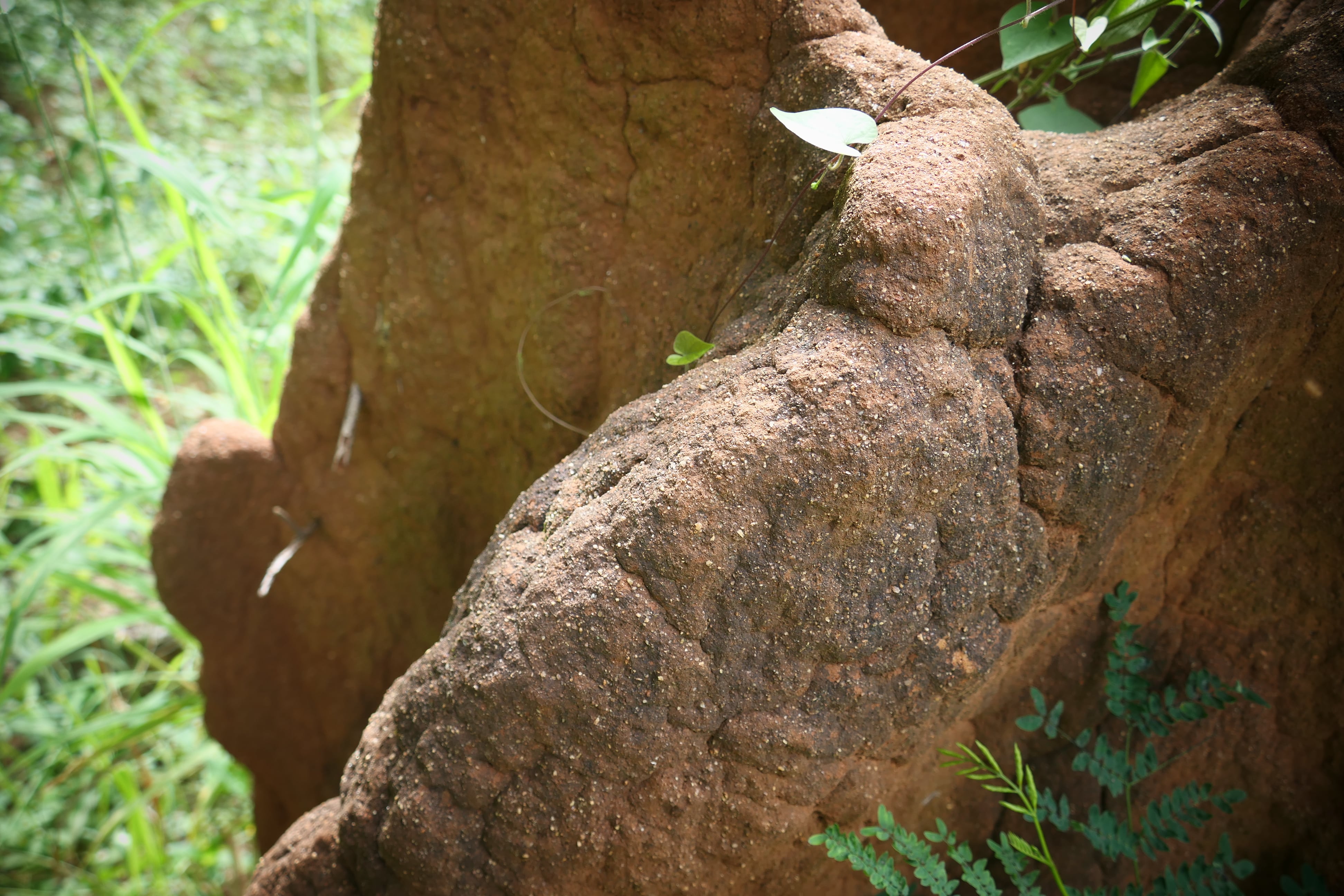
Just after May showers, we scan the base of mounds hoping for a harvest of the large, satin-smooth Termite mushroom, a specie of Termitomyces. Thick and fleshy with a distinct aroma, these mushrooms make for the best curry we have ever eaten. The mutualism between Termitomyces, farmed in fungal greenhouses as in-house food resource, and termites is a boon as it enhances nutrient concentration in the surrounding soil. The ecological impact of termite activity involving physical, chemical, and biological processes makes them partners in the restoration of degraded lands. Their towers dotting the landscape are a part of our story, too.
It is a castle that breathes and ventilates naturally, influencing the soil micro-climate in the immediate vicinity.
Also read: What it takes to breathe life into degraded farmland
Coiled pellets of soft earth tell tales of earthworms living their lives, weaving through the layers of soil and biomass. The earthworm is the proverbial ‘friend of the farmer.’ There are several ‘friends;’ species which are not so easy to identify, considering they are confined to the deep mineral layers and are seen only when we dig deep. The two most familiar ones are the horizontal burrowers that live in the soil (endogenic), whose castings I find on the vegetable beds or in the basins of fruit trees, and the composters in the vermicompost pits that live in the top organically-rich layers (epigeic).
The earthworm is the proverbial ‘friend of the farmer.’
While they burrow, endogenic earthworms draw dead organic matter such as leaf litter into the soil, feeding on organic matter, soil and on decayed plant roots. They make the farmer’s task easier by improving tilth and fertility, soil structure, aeration, drainage, and aggregation, increasing the capacity to hold moisture—conditions ideal for plants to put down healthy roots. Organic waste and fine soil passing through the gut as castings are rich in enzymes that break down organic matter, act as pest protection, and provide natural hormones conducive for growth. Leaf composts such as biodynamic mixed leaf composts and mulches are effective ways to attract these earthworms. In a sense, they are in-situ composters!

Epigeic earthworms such as the African nightcrawler (Eudrilus eugeniae)—the ones used to make vermicompost—convert animal dung and biomass into a fine silky, smooth substance; a component of humus, deposited on the surface of the compost. They are voracious feeders with a ‘sweet tooth.’ A weak solution of jaggery or a sprinkling of Panchgavya over the layers of biomass and cow dung is an elixir that seems to whip up their appetite.
Both are invaluable for agriculture, but the main difference is that the castings of endogenic worms are mineral-rich, and the vermicompost produced by epigeic worms is rich in plant nutrients: macronutrients such as nitrogen, phosphorus, potassium, calcium as well as micronutrients. While root vegetables thrive in beds populated by burrowers, leafy green vegetables and heavy feeders like cucurbits do well with applications of vermicompost.
An agricultural landscape is far more diverse than what is generally construed. I imagine the support system to be an upside-down triangle with the base up, the farmer being right at the bottom. Good practices, whether it is composting, mulching, or crop rotation, are beneficial because they support insects, worms, and other macro-organisms which, in turn, act upon these substances to create a beneficial environment for the real agents in the vibrant, multifarious realm of the soil microbiome. These unseen soil microbiota deliver what plants need: nutrients in an absorbable manner, protection from disease, stimulation of growth processes and a support network.
When we welcomed the wilderness into our agriculture space, the lines blurred. What we experience today is not the controlled environment of a farm, but a loosely structured farm-wilderness where the farmer has a limited role—the one she shares with fellow creatures.
What we experience today is not the controlled environment of a farm, but a loosely structured farm-wilderness where the farmer has a limited role—the one she shares with fellow creatures.
Artwork by Khyati K
{{quiz}}
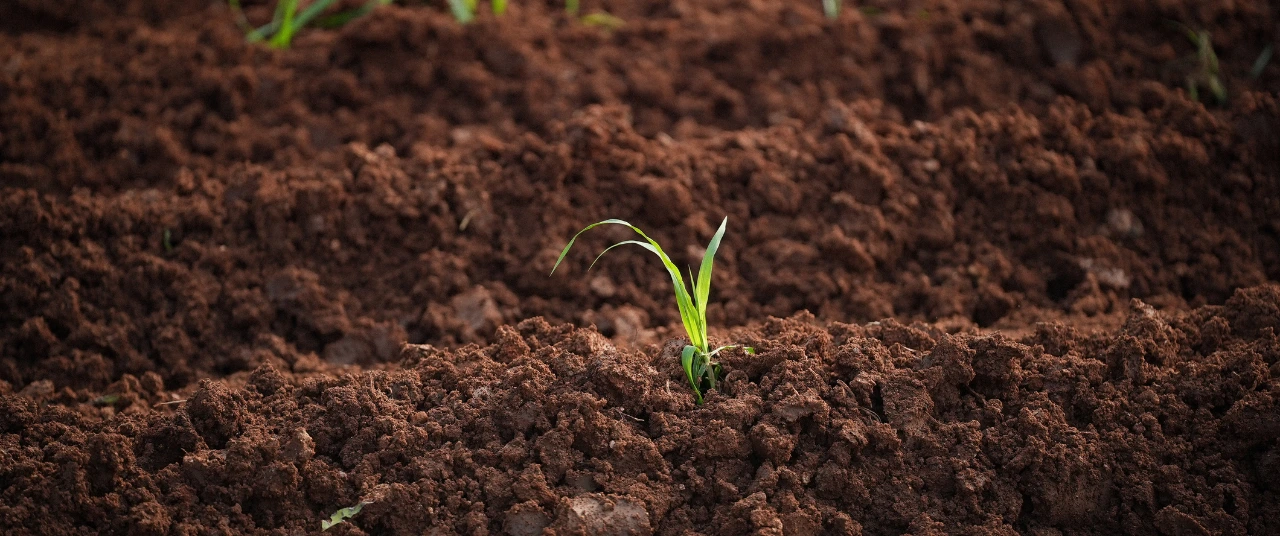
Syncing with the monsoon is important for a rain-fed crop like ragi; sowing too early or late has a direct effect on harvests
Editor's note: Even before its current status as a nutrient-rich superfood, ragi has been a crucial chapter in the history of Indian agriculture. Finger millet, as it is commonly known, has been a true friend of the farmer and consumer thanks to its climate resilience and ability to miraculously grow in unfavourable conditions. As we look towards an uncertain, possibly food-insecure future, the importance of ragi as a reliable crop cannot be understated. In this series, the Good Food Movement explains why the millet deserves space on our farms and dinner plates. Alongside an ongoing video documentation of what it takes to grow ragi, this series will delve into the related concerns of intercropping, cover crops and how ragi fares compared to other grains.
Every cropping season in India begins not with a seed, but with the sky. For generations, farmers have read the rhythms of the monsoon like a living calendar—each phase of rain marking a specific agricultural activity. In Karnataka’s dryland regions, this relationship between rain, soil, and crop choice forms the foundation of sustainable farming.
The Good Food Movement is growing ragi on a 2-acre plot in Tumakuru district’s Tiptur town using traditional, organic methods and documenting the entire process, from sowing cover crops, to choosing the right seeds, to planting, sowing and harvesting.
This article aims to provide an overview of the cropping conditions in Tiptur to understand what goes behind a successful ragi harvest cycle in these dryland landscapes.
Karnataka is divided into the more forested regions of Malnad in the West and the open lands of the Maidan in the East, each with its own land use and settlement culture. Agriculture is more commonly practised in the expanses of the Maidan. Tiptur sits in the South Maidan zone of Karnataka. This is a semi-arid region characterised by red-brown soils and undulating terrain. Tiptur’s landscape in particular is home to vivid red, loamy soils.
The region’s average annual rainfall ranges between 700-900 mm. Tiptur, being on the leeward side of the Western Ghats, is on the lower range of this rainfall spectrum, receiving about 680-720 mm. Most of this rainfall occurs during the southwest monsoon (June to September), which nourishes the Kharif crop cycle. Average temperatures stay between 24°C and 34°C across the year. These conditions make Tiptur ideal for millets like ragi, along with pulses and oilseeds that thrive in well-drained soils and intermittent rainfall.
Each phase guides what happens on the farm, from preparing the land and sowing cover crops, to mulching, and the final sowing of ragi.
In this landscape, rain is a planning tool. Farmers track the traditional nakshatra (constellation)-based rain calendar, using the names of constellations like Revathi, Ashwini, and Rohini to track rains throughout the year. In Kannada, Mungaru refers to the crucial southwest monsoon, while the Hingaru or northeast monsoon (October–December) supports Rabi crops. Each phase guides what happens on the farm, from preparing the land and sowing cover crops, to mulching, and the final sowing of ragi.
Also read: Why Akkadi Salu, an ancient practice of intercropping ragi, deserves a comeback
The cropping season begins around March-April, long before the main monsoon showers arrive. Farmers begin tilling and preparing their fields, before the first Revathi rains. This is followed by the sowing of cover crops—crops that are grown before the main crop to prevent soil erosion and replenish soil nutrients. Though there isn't a fixed rule for which crops to select, it is recommended to incorporate 80% as legumes for nitrogen fixation and 20% as non-legumes to maintain diversity. In our experiment, we used a mix of sunn hemp, spiny sesbania, horsegram, mustard, sesame and cowpea.
This stage, often overlooked in conventional agriculture, is crucial for restoring the land. The cover crops fix nitrogen, protect the topsoil from heat and erosion, and naturally add biomass once they are mixed back into the soil. As they mature, often growing 4–6 feet tall by the onset of the Mungaru rains in June, they create a dense green canopy which lowers soil temperatures, compared to land exposed to the sun.
The arrival of the southwest monsoons in June marks the onset of the Kharif crop cycle. The matured cover crops are tilled back into the soil using a rotavator in time for planting the main ragi crop. This produces green manure, a natural nutrient source that boosts soil fertility and microbial life. Around 16 tons of fresh biomass per acre can be generated in this phase, part of which contributes to long-term soil carbon.
Also read: A crop for the future: Why India should invest in ragi and its climate resilience
It’s important to sync the harvest cycle of ragi, a hardy millet and dietary staple in this region, with the Kharif monsoon cycle. Cover crops are sown to align with the onset of the first Ashwini rains. Thereafter, ragi is typically sown in late July—once the soil has absorbed sufficient monsoon moisture and the decomposed biomass. Farmers rely on consistent showers during the Pushya and Ashlesha (mid-July to mid-August) rains to aid germination. The Tumakuru district experiences the last of its rainfall in mid-October. By this time, the crop should have reached a healthy maturation rate of 70-80% so that it can be harvested in November. Syncing with the monsoon is especially important for a rain-fed crop like ragi: if you sow too early, harvesting might become difficult during heavy rains. Sow too late, and the soil may lose its moisture.
Rainfall patterns in Tiptur have become increasingly erratic over the last 5 years, in terms of both the number of rainy days and the quantum of rainfall received during a specific period. Delays during Mrigashira and Ardra (June and early July) mean that cover crops mature under limited moisture, forcing farmers to adapt dynamically—sometimes switching to short-duration millet or pulse varieties if rains fail to arrive on time.
This adaptive approach—watching the skies, responding to soil feedback, and making crop decisions in real-time—is the essence of rain-fed agriculture. Unlike irrigated systems, farmers here depend entirely on the sequencing of natural rainfall, balancing risk and regeneration.
This adaptive approach—watching the skies, responding to soil feedback, and making crop decisions in real-time—is the essence of rain-fed agriculture.
The red loamy soil of Tiptur is moderately low in organic carbon—which makes regenerative practices like cover cropping essential. Integrating organic manure and green biomass helps rebuild the soil’s structure, improving its ability to retain moisture and nutrients during dry spells.
By sequencing operations with each nakshatra calendar, farmers turn uncertainty into a working rhythm. Land is prepared and a layer of mixed cover crops is sown during the pre-summer rains. These grow into a canopy, and are re-incorporated into the soil during the early monsoon at the beginning of the Kharif season. Ragi is sown once the soil absorbs the biomass, and is then harvested when the spikes turn brown.
Agriculture is a dialogue between soil ecology and seasonal uncertainty. The Kharif cycle, too, isn’t merely a harvest calendar or a farming schedule. Each rainfall event, each temperature shift, reshapes the farmer’s decisions. Through cover cropping, green manuring, and careful timing, the land learns to breathe again between harvests.
Also read: The grain divide: How ragi and rice compare in the field and on our plates
Please try another keyword to match the results
